
The Enduro 3 is here, and seemingly has one mission, and one mission only: Go big on battery. Nearly triple their competitors, upwards of 320 hours in a regular GPS configuration. At least in theory, anyway. But fear not, I’ve been testing that.
Oh – and the kicker? It’s $200 cheaper than the Fenix 8 Solar, yet has all the same software features. For real.
The Enduro 3 essentially takes all the functionality of the existing Fenix 7X Pro (including that ECG-capable sensor, offline music, payments, etc…), and merges it with the new software features and user interface of the new Fenix 8 Solar. And atop that (literally), they revamped the solar display to be 120% more powerful, and improved the display clarity by concurrently removing the majority of the solar panel surface. Don’t worry, I know that sounds confusing, I’ll explain more below.
The result is a watch I’ve been beating to death over the last little while, across epic hikes in the Pyrenees, rides, runs, swims, and more. All in the pursuit of, mostly, figuring out just how far I can push the battery life. Albeit, I admit that unlike my Enduro 2 test, I wasn’t able to allocate however much time was required to hike until the battery died. Not sure my kids would want me gone for a month.
In any case, as always, I’ve been putting all these units to the test with crazy long mountain hikes, runs, rides, swims, dives, and more. Finally, note that Garmin sent over media loaner units to test out. As usual, this review is not sponsored (nor does any company get to preview anything I review), and I don’t take any advertiser money from any companies I review. Once this unit goes back, I’ll go out and buy my own for any future testing needs. If you found this review useful, you can use the links at the bottom, or consider becoming a DCR Supporter, which makes the site ad-free. And, of course, it makes you awesome.
(Oh, quick note: I’m experimenting with doing certain reviews a bit differently, namely ones where things have boatloads of overlap with concurrently released products, like the Fenix 8 yesterday. So in this review, I’m focused on spending more time on geeking out on the differences and what they mean, versus spending time writing about how to look at your steps and basics. Might tweak later on a rainy day.)
What’s New & How it Differs:
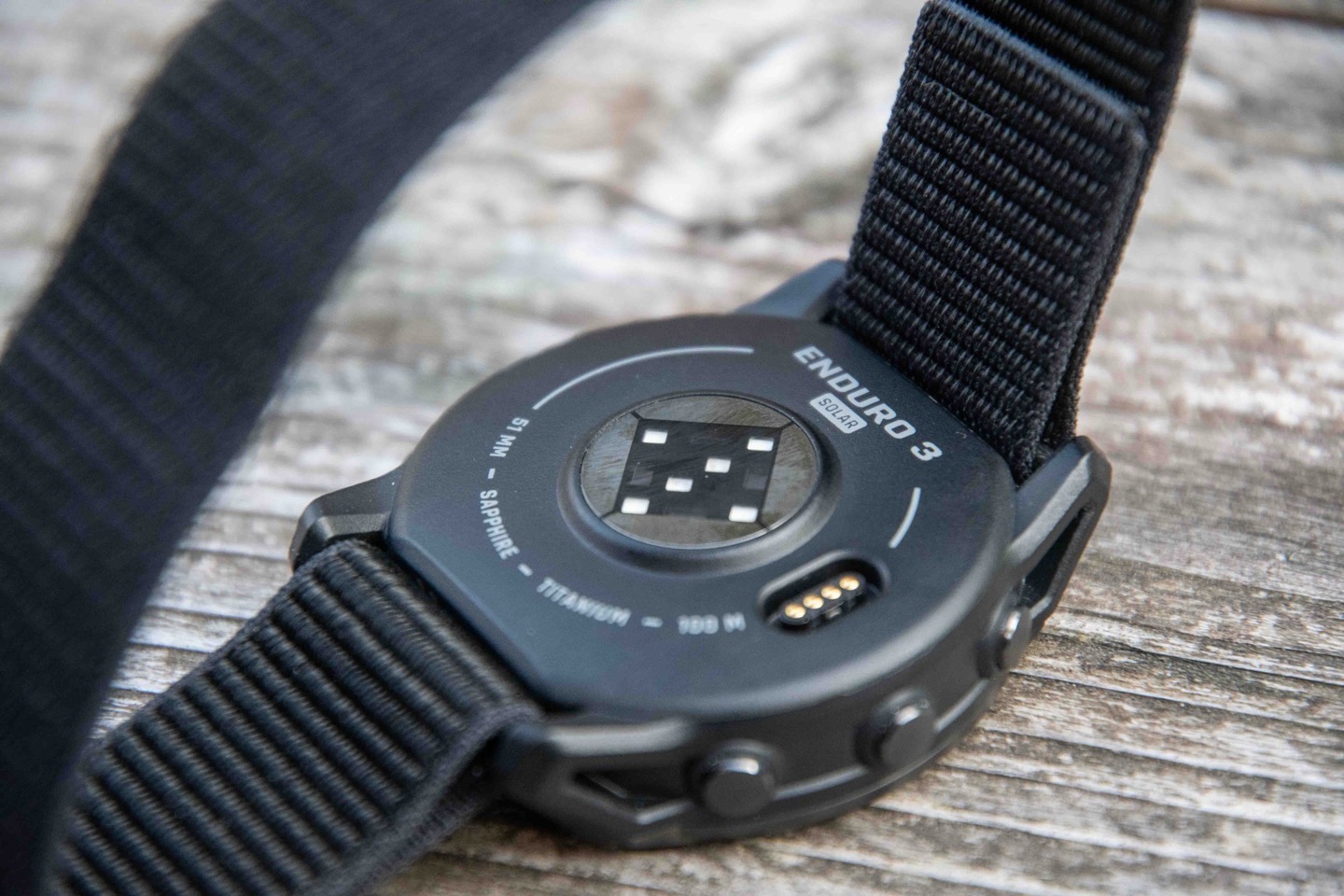
What’s actually more interesting though, is that in its third iteration, Enduro has had a rather dynamic life. At least in terms of its hardware parents. Here, let me explain (and, why this matters):
Enduro 1 (2021): For this first edition, Garmin took a Fenix 6X Pro, and gutted all the features people actually cared about to achieve higher battery life, including maps, leaving you with breadcrumb and battery. Obviously, this didn’t go over well in the real world, because the exact people that wanted the battery life, very much wanted maps. Still, it put a marker in the sand for Garmin.
Enduro 2 (2022): For this second go around, Garmin took the Fenix 7X, and simply gave it a bigger battery. It had all the features of the Fenix 7X, just more battery, a slightly bigger case, and actually even a new flashlight twice as bright as the Fenix 7X (that would eventually become standard on the Fenix 7 Pro, and now Fenix 8).
Enduro 3 (2024): Garmin is now splitting the difference. Think of this more akin to a Fenix 7X Pro, but with the user interface and software features of the Fenix 8. It doesn’t have the speaker/microphone or dive features of the Fenix 8, but it has all the software features. It’s also got a redesigned solar panel to give it crazy battery life.
In other words, I’d actually argue that out of all of today’s releases, the Enduro 3 embodies the product that Garmin listened to the customer base most carefully on. Most of the Enduro users have said they don’t care or want smartphone features like microphones or speakers. And thus, Garmin seemed to give them what they want.
First though, let’s dig into exactly how the Enduro 3 differs from an Enduro 2:
– Price reduced from $1,099 to $899 (seriously, they actually decreased the price)
– Added new Garmin Elevate Gen5 Optical HR sensor (ECG and wrist-temperature capable)
– Increase the battery life claims substantially
– New solar technology, increases solar harvesting (2x energy of Enduro 2), but also increases clarity
– Increased thickness of solar band around outside edge, changed to black
– Removed transparent solar panel across surface of display (increasing visibility)
– Enduro 3 case/housing is 57g
– Enduro 3 UltraFit band is 6g
– Enduro 3 total weight is 63g (compared to 69g on Enduro 2)
– Revamped user interface, found on the Fenix 8, which adds the following list of items
– Added new maps radius zoom UI change
– Added new maps North Up quick toggle
– Added new maps layer selection quick access menu
– Added quick access touch unlock feature (temporarily unlocks touch, such as for a map during workout)
– Added new ‘Active Navigation’ menu system while navigating a course/waypoint/etc
– Added new consolidated ‘Saved’ feature, to find saved routes/waypoints/etc..
– Added new dynamic round-trip routing, to auto—change route mid-way to achieve a specified distance if you go off-course (e.g. set for 5 miles)
– Added ‘Set a Target’ distance reminder, to remind you to turn around after the half-way point
– Added Ski difficulty tracking option
– Added strength training plans (4-6 weeks, via Garmin Connect)
– Added new watch face editor, and new watch faces
– Added new Countdown app to countdown to various dates/events
– Added new Focus Modes
– Added new online processing of troubled GPS tracks, using internal watch sensor data to correct them
– Major redesign of user interface, including widgets, settings, and activity/workout pages
– Revamped Notification Center to include Garmin-based notifications (e.g., Morning Report or Daily Summary)
Phew, got all that? Good.
And here’s how it differs from the also-released Garmin Fenix 8 Solar:
– Enduro 3 doesn’t have speaker/microphone features (does have a normal beeper)
– Enduro 3 doesn’t have dive features
– Enduro 3 offered in a single larger size (51mm), versus multiple Fenix sizes
– Enduro 3 has bigger solar ring around the outside
– Enduro 3 is lighter at 63g, versus 95g for 51mm Fenix 8 Solar
– Enduro 3 is thicker at 15.7mm versus 51mm Fenix 8 Solar at 14.7mm
– Enduro 3 is priced at a more reasonable $899, versus $1,199 for the 51mm Fenix 8 Solar
– Both 51mm Fenix 8 Solar & Enduro 3 have same 1.4” MIP display @ 280x280px
– Both have Sapphire glass, and Titanium
– Both have 32GB for maps/music
Beyond that, all other features are the same. Thus, things like offline music, contactless payments, daily activity tracking, etc…are all identical to the Fenix 8 Solar.
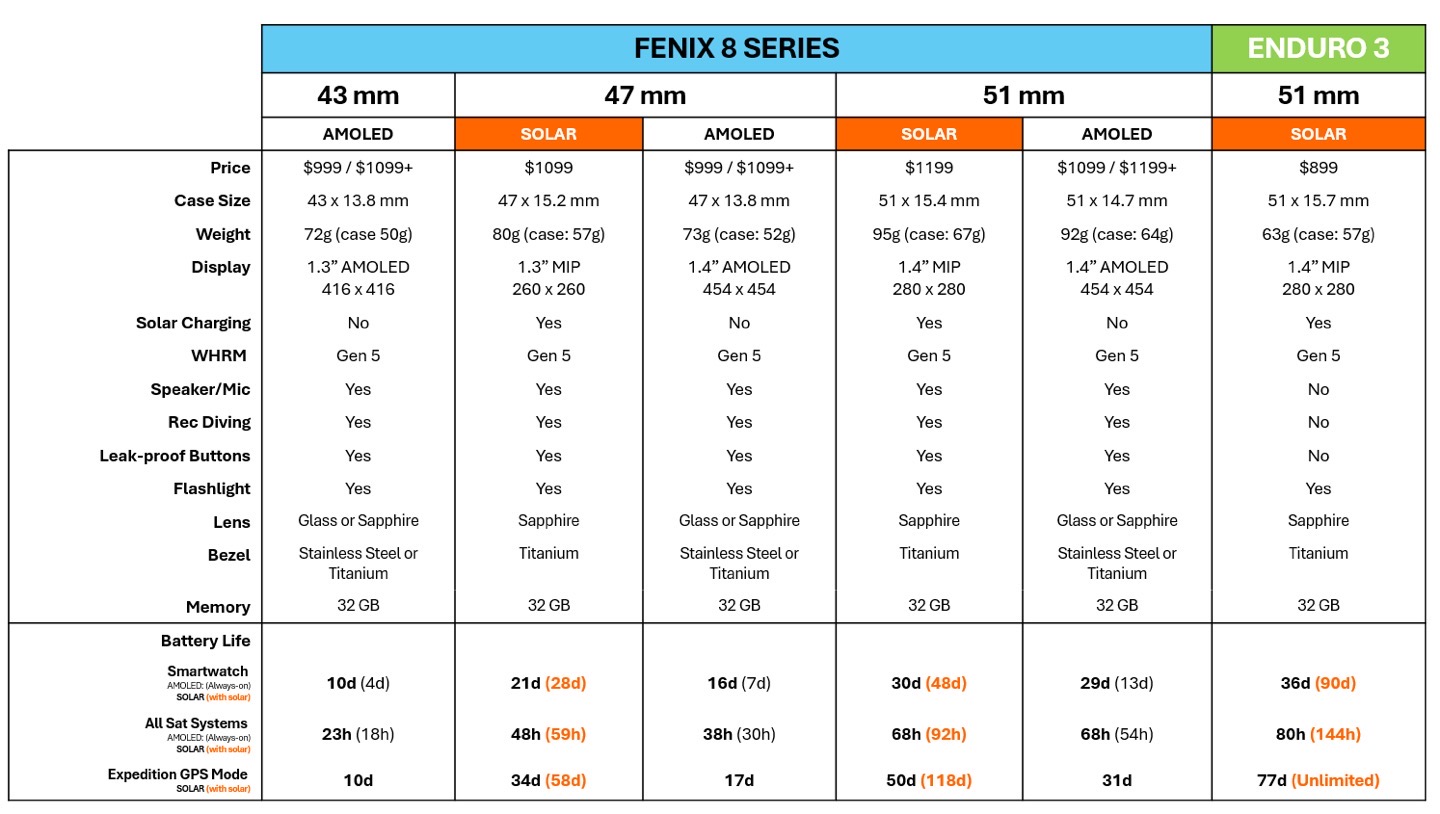
Looking at the battery life, I made a little chart showing the differences, which are exceptionally notable in the GPS-only mode:
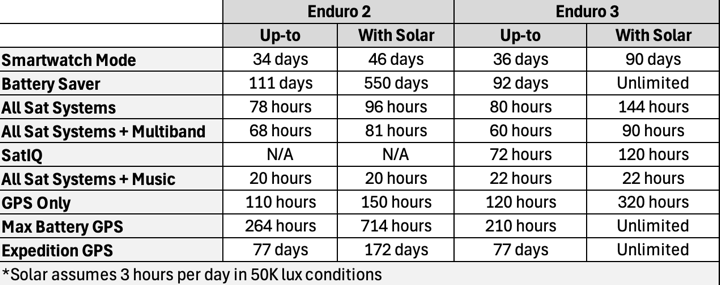
The new solar panel gets 30 minutes of GPS battery life for every 60 minutes of sunlight, whereas Enduro 2 got only 15 minutes of GPS battery per 60 minutes of sunlight (assuming 50K lux conditions).
Again, this is all about battery life. So, let’s test it. But first, let’s talk about the new UI features briefly.
New UI & Navigation Features:
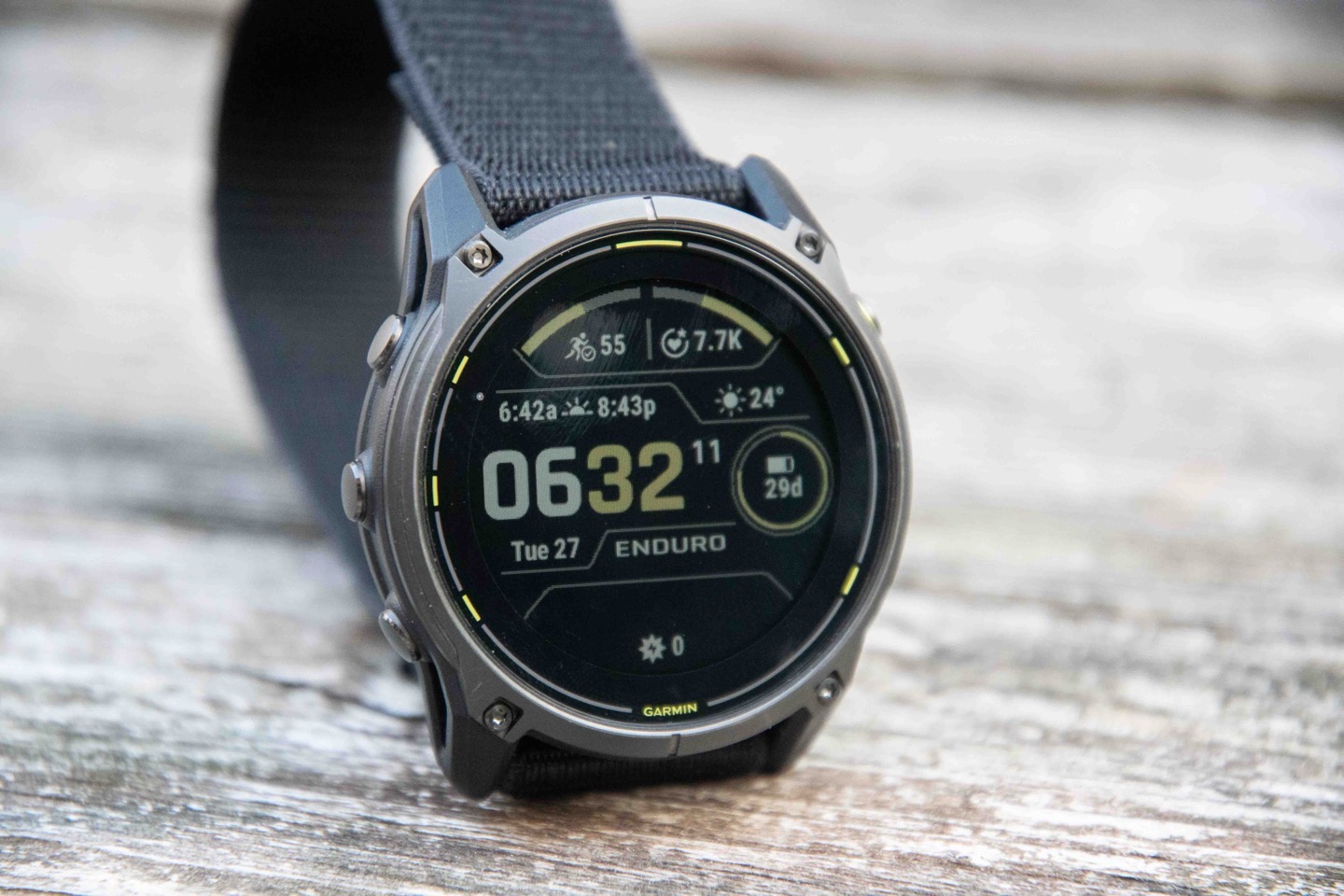
The new user interface over on the Fenix 8 is also on the Enduro 3. This user interface won’t be going back to any previous watches, only the current gen units and beyond. Roughly speaking, you can divide it up into three core categories:
– Barely revamped widgets/glances
– Significantly revamped settings area
– Moderately revamped data field and navigation pages/structure
Starting off with the widget glances and such, these will feel all basically the same on the Enduro 3, since the MIP version of the Fenix 8 doesn’t get as big of a revamp in this area, as that’s largely reserved for the AMOLED capabilities with higher resolutions, colors, etc… So as you can see below, basically same-same.
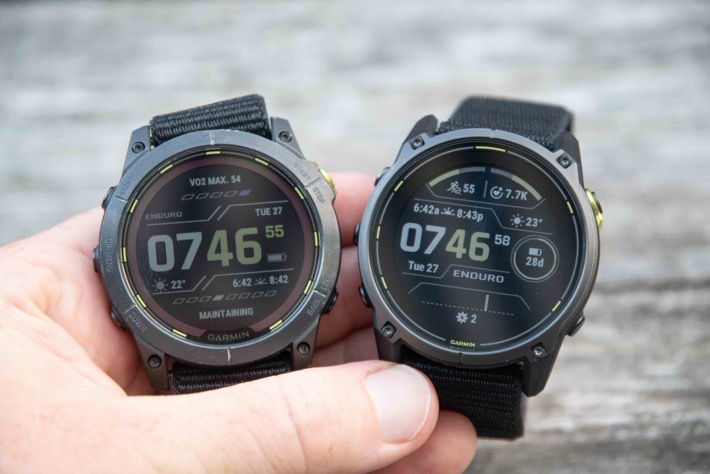
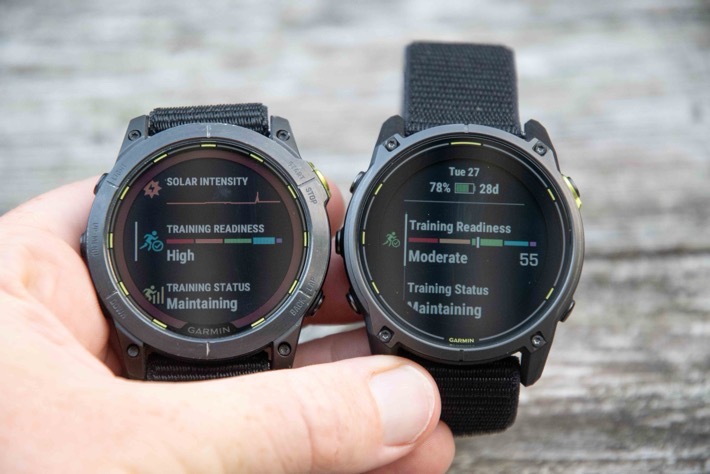
However, the settings are where you’ll see a number of changes, as Garmin consolidates settings into the most used areas and new groupings. The most frequently accessed settings groups are at the top, while the others are lower down in the list. On the whole, I’m a fan of this, and it works well.
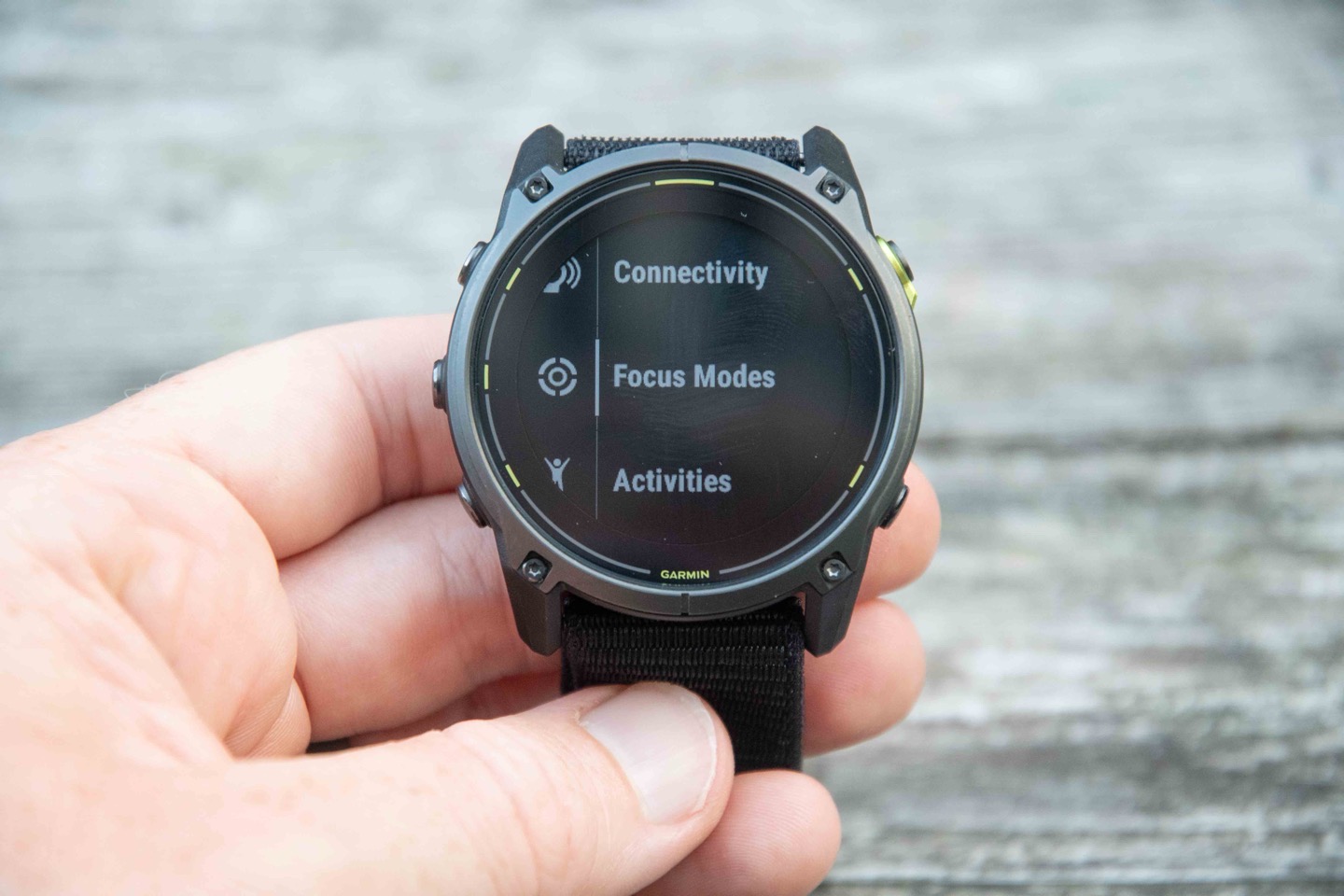
In fact, the very first option either the Fenix 8 or Enduro 3 will ask you when you power it on for the first time out of the box, is the font size. All the photos here are with the default size.
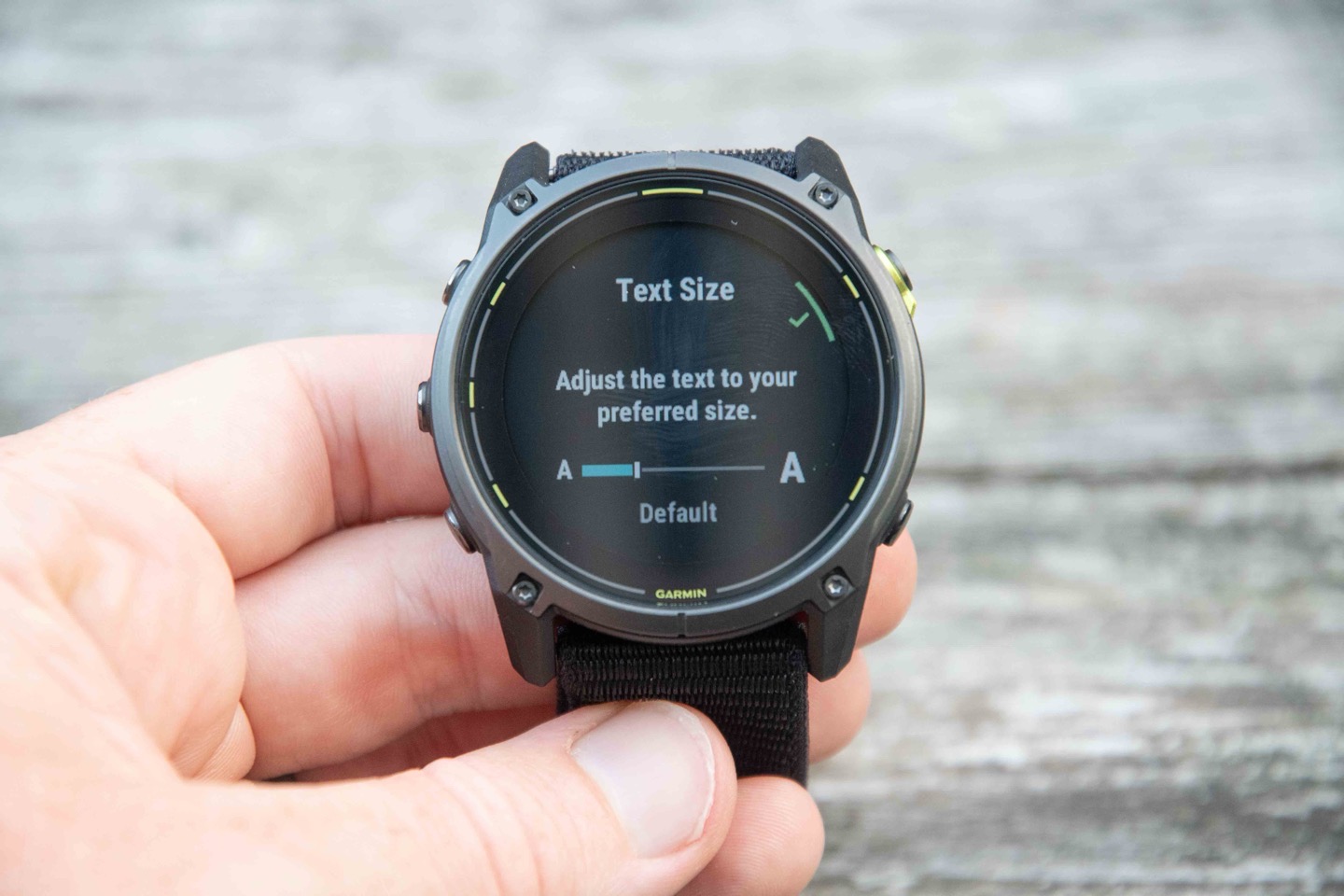
Moving along though, let’s press the upper right button to start a workout/sport/app. This is where we’ll see the new menu to choose our favorited activities. Here we can select three items for the first row, with the remainder of the sports under those four dots to the upper right. Below that, are non-sport apps (stuff like Music, Garmin Share, Messenger, etc…)

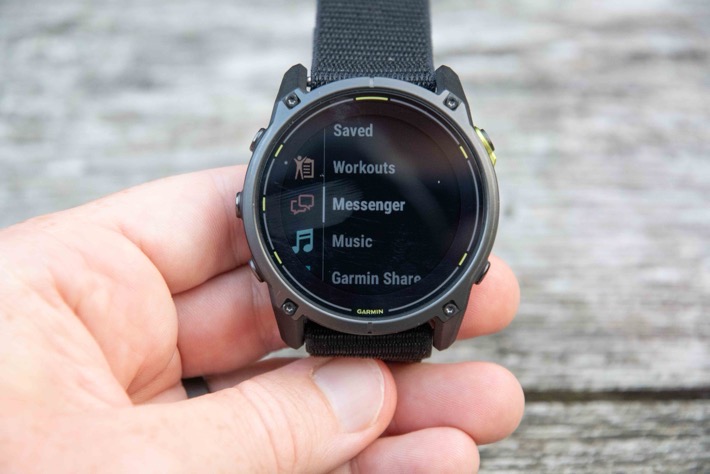
The idea here being to make non-sport apps more obvious, and less buried in the menu. The downside there is that it requires more button presses to get to sports beyond your top three.
If we have other sports, we can scroll further and see them categorized. The slight change here is that these extra sports aren’t as hidden, which is probably useful for new-to-Garmin users, to make it more obvious just how many sports Garmin has.
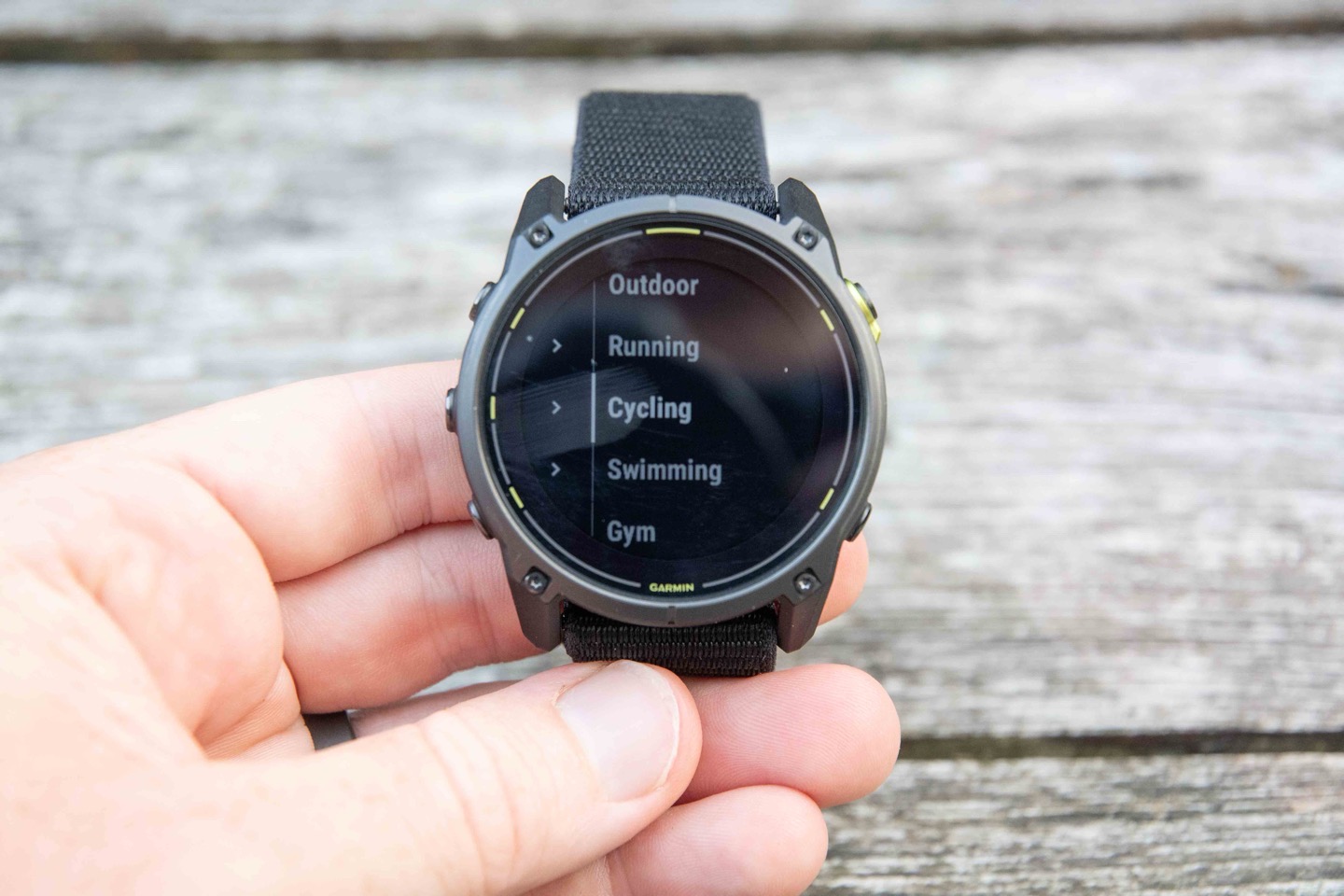
After selecting the sport we want, the upper portion of the page will look familiar, as it’s the GPS waiting screen, and sensor/etc waiting screen. The upper right button will start the workout like before. However, down below you’ll see there are easily accessible settings pages. Daily Suggested (or planned) workouts show up here automatically, and routes are easily accessible as well:
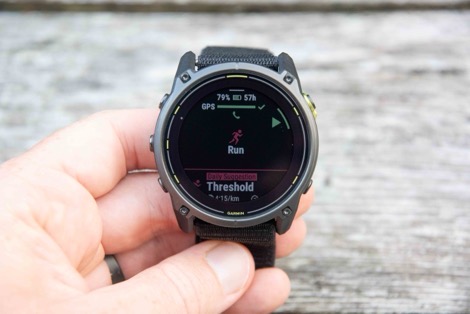
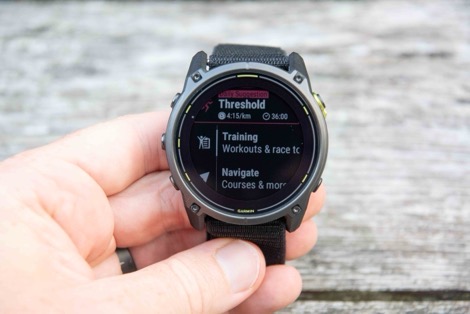
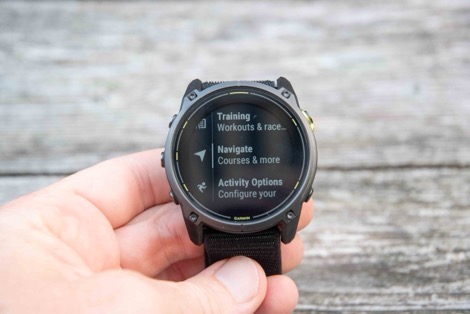
Routes and navigation items are re-arranged into a new control panel as well, including a new ‘Saved’ bin, that puts them under one umbrella, as opposed to all over the place. Here I can select the route I want:
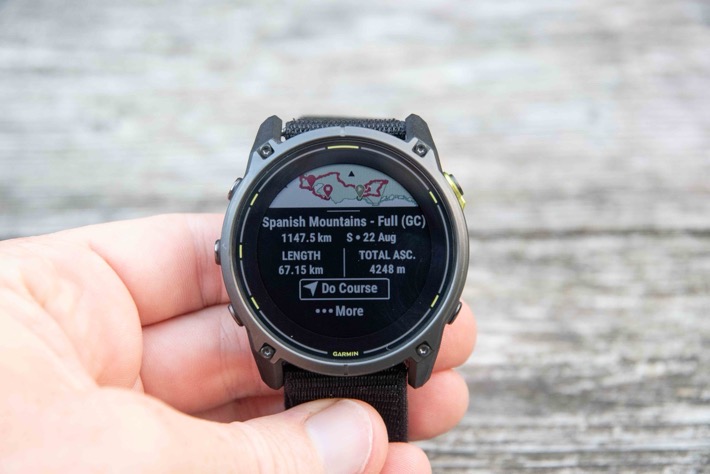
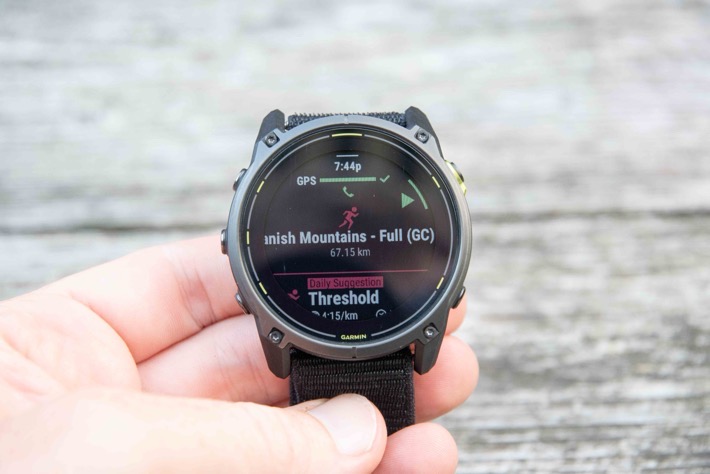
Once that’s done, you’ll see it listed back on the main sport waiting screen:

At this point, off you go, to start your workout/activity. Except, there’s been a redesign here too. Instead of just scrolling up/down through data pages like every past Garmin watch, you can now swipe left/right within three lanes (like lanes in a pool).
Lane 1: The settings page where we started the activity from + navigation bits
Lane 2: Your data pages/fields as you knew them from the past
Lane 3: Music controls
At present, you cannot disable the music control page, but that’s apparently coming. If you’re not navigating, you’ll just live in that middle lane, and really not think about it. If you go to long-hold the middle button to access settings, it just pulls you back to Lane 1.
Below, you can see me in my ‘normal’ data pages, and if you look at the right image, you’ll see the indicator as to which of the three lanes I’m in at the bottom.
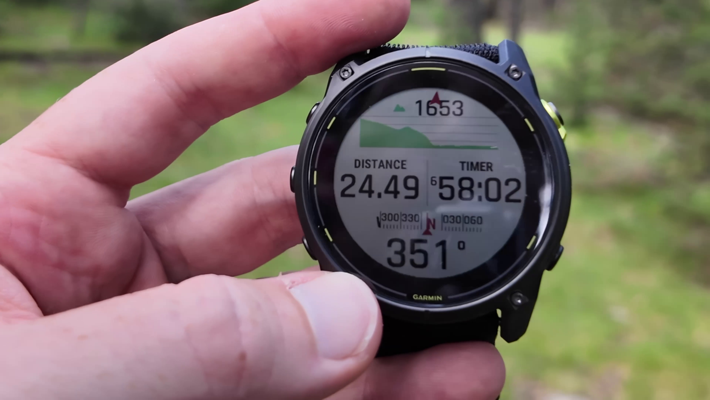
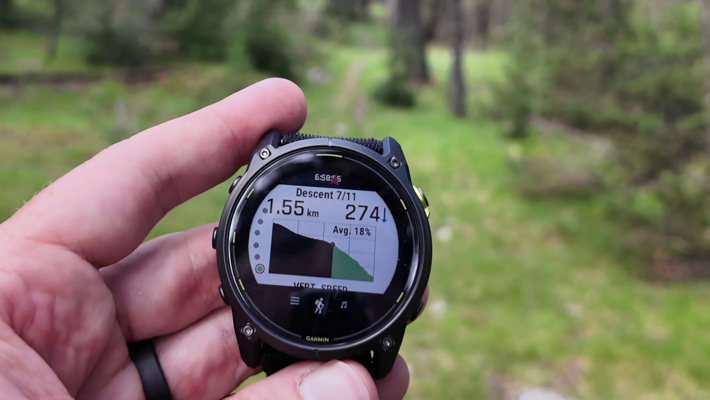
And if you swipe to the right, you get to the music controls (for any music you have on your watch, or phone). Again, you can see the lane now showing ‘Music’ at the bottom.
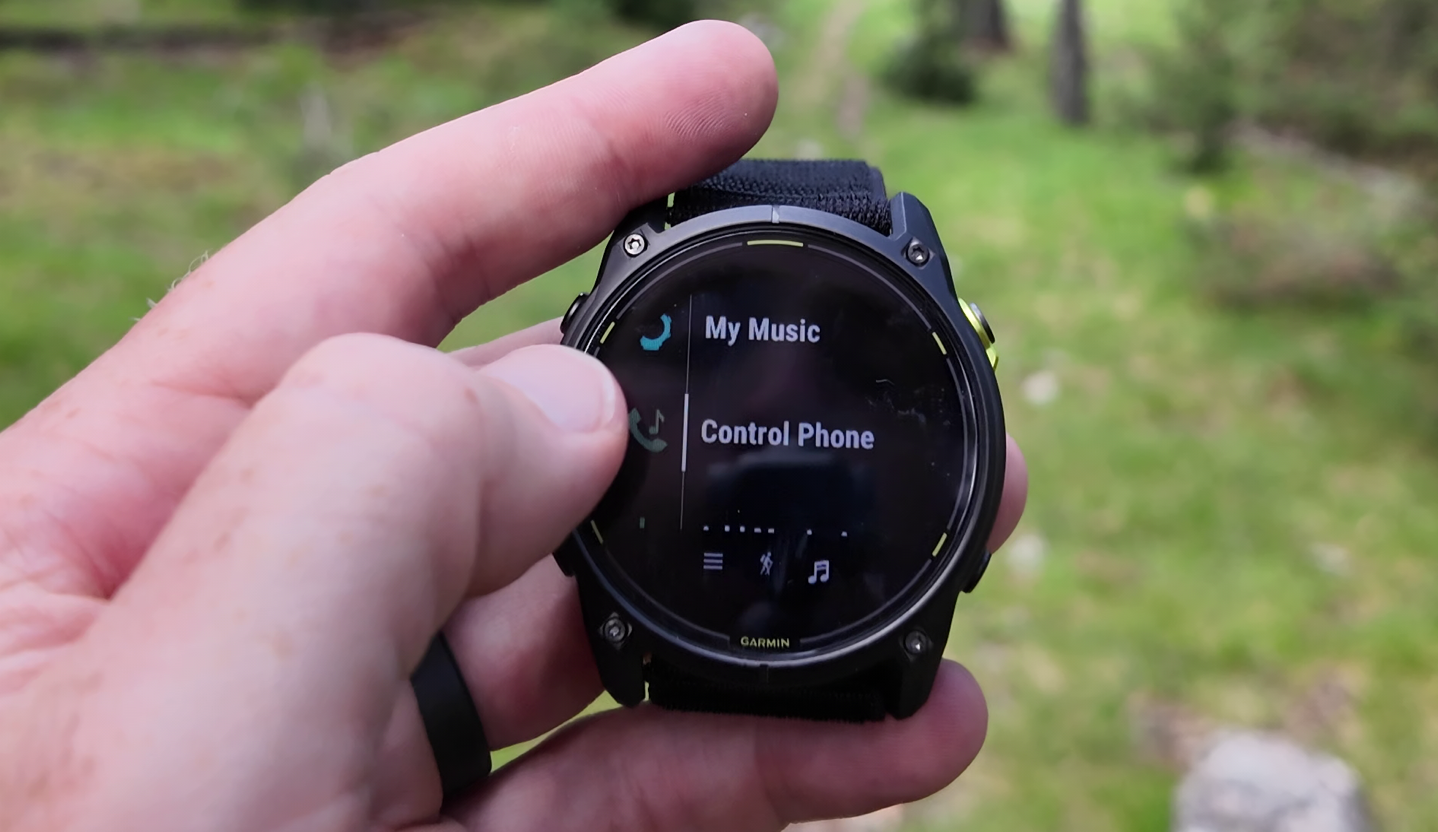
However, where it gets different is if you’re navigating, then you get a new option that shows up within that first lane that you can open up to see a dedicated set of navigation pages. Think of this like multitasking apps, and that this doesn’t affect your main data pages. The rough idea is that people end up with sport profiles jammed with all sorts of extra data pages they only use when navigating, but stay there cluttering up their data pages for all other workouts. This tries to solve that. Here you can see the left swipe first (to the hamburger three-lined menu), then I tap into ‘Spanish Mountains’, and I see four pages of navigation-related data pages, starting with a split-screen map, then ETA, and so on (I show this fully in the video).
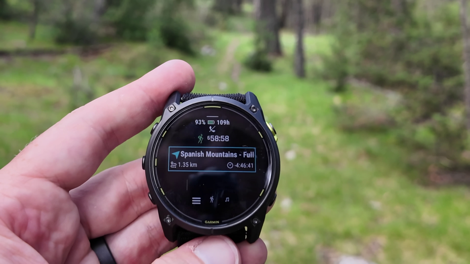
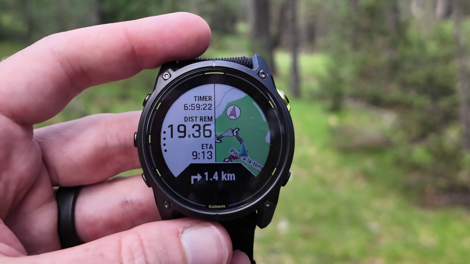
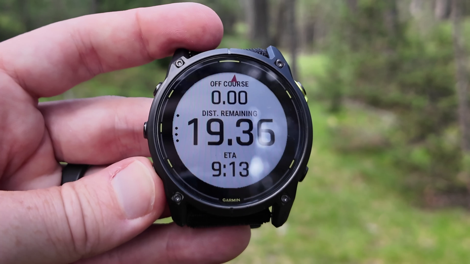
In reality, I don’t think they’ve solved it quite yet. Now I’ve just got even more data pages, and those data pages aren’t consistent either. ClimbPro shows two different things depending which lane I’m in, and atop that, getting to the navigation pages requires even more swiping/tapping/entering. I see the dream, but right now it’s just not executed as well as I’d like, and has resulted in just more pages than before (especially since I don’t even want the music one either).
There’s three other tidbits worth noting. First is that you’ve got a touch unlock option to quickly use touch on the map page. You simply tap the little touch icon, and then swipe down, and it temporarily unlocks it. This is cool and super useful:
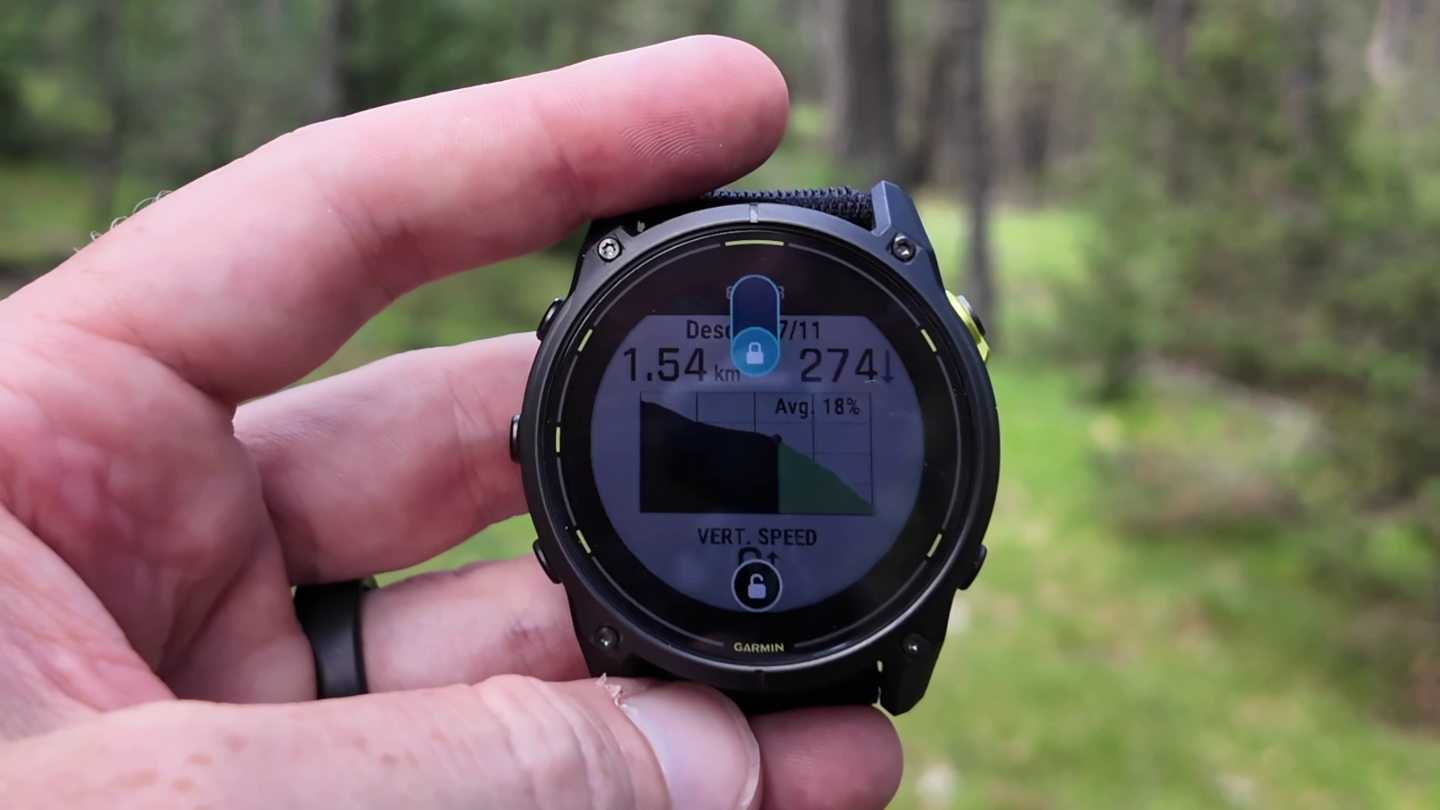
The second is you can tap the compass icon on the map page to instantly switch between North Up view and direction of travel view. And the third, is that you can now quickly toggle between map layers (such as popularity routing, shading, etc…) right from within the activity and map page.

This also lets you toggle between different maps quickly as well, such as if you had the Garmin Outdoor+ maps (satellite imagery, among others). This piece is actually pretty slick, and far faster than before.
Beyond these items, virtually all other elements from a sports/fitness standpoint are the same. This is true of things like sensor pairings, navigation features, training load and recovery features, etc… So instead, let’s move into the solar panel components and battery pieces.
The Solar Panel, and Battery Testing:
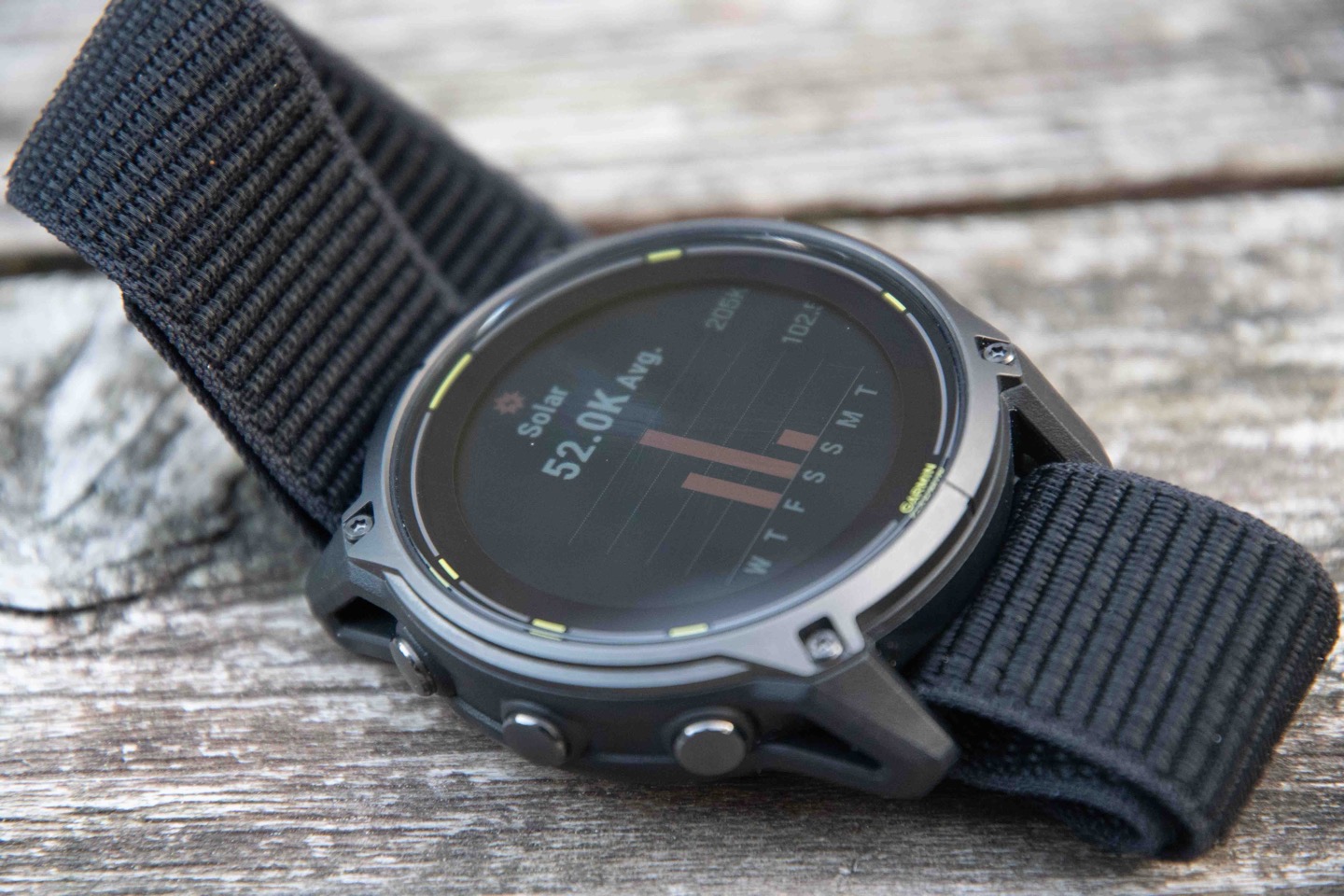
The biggest change on the Enduro 3 is the Solar panel. Specifically, there’s three changes here:
– A new technology altogether, increasing the outer solar ring to get more battery life
– Made the outer solar ring black, versus red, so you don’t really notice it as a solar ring (appears like the bezel)
– Removed the transparent solar panel over the screen/display portion, increasing visibility
So, looking at them side-by-side, you can very easily see the difference between the red vs black rings around each one, and how much thicker the Enduro 3 is:

Regarding screen clarity, yes, that too seems clearer to me. I wouldn’t describe it as massively clearer, but slightly clearer:
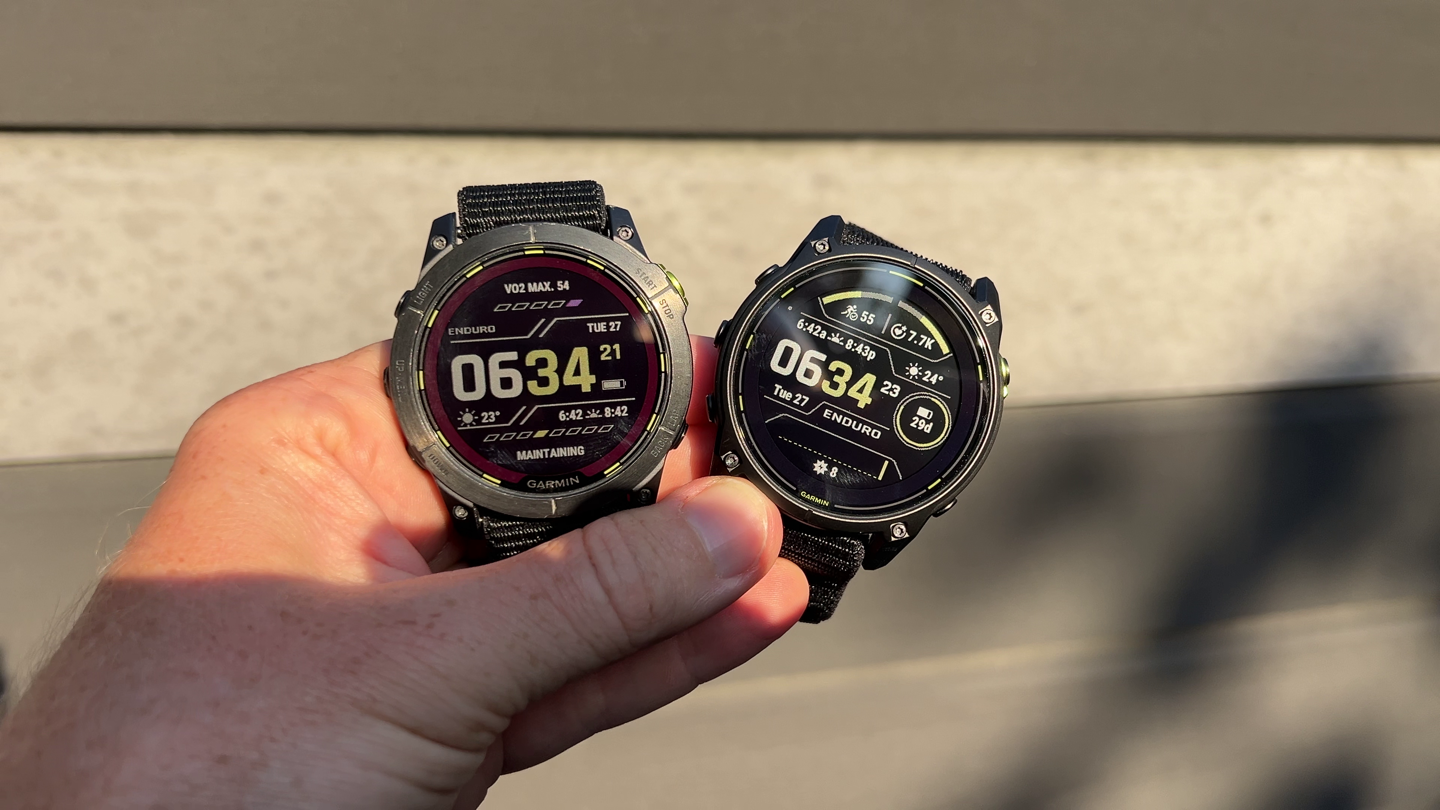
However, I will say, using it side by side with the Fenix 8 (AMOLED), I forget how bad screen visibility is compared to AMOLED watches in dimmer settings. There was one particular moment on our first hiking day where we were in the forest, and trying to confirm our directions, when I looked down at the Enduro 3, and the display was completely unusable from a visibility standpoint. At least without turning on the Enduro 3 backlight, which Garmin specifically made a point in the media briefings as saying wasn’t needed. Yet both myself and Des looked at our respective wrists, and given the map shading used in that particular area, on the Enduro 3, it made it quite challenging to see without enabling the backlight):
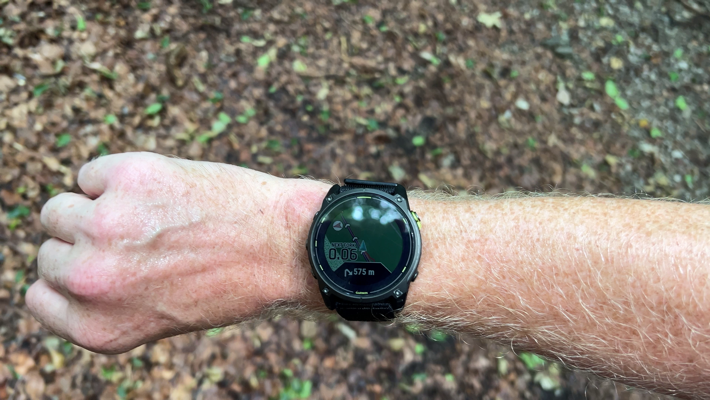
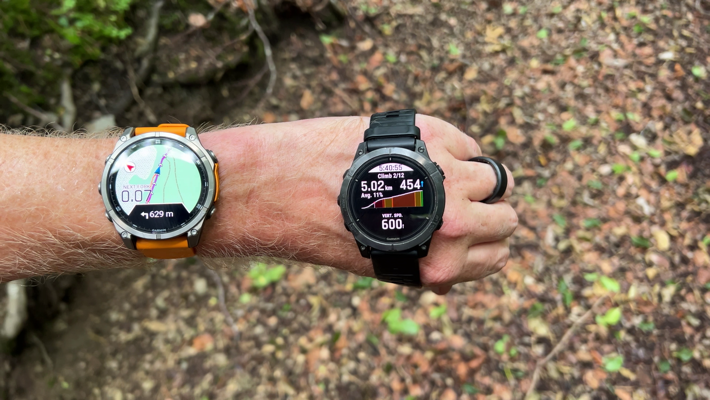
Yet inversely, when I was on top of a ridgeline in bright sunny conditions, I had ZERO issues viewing any of the AMOLED display units (taking photos of AMOLED displays in bright sunny conditions is always challenging because your camera will first expose the brighter areas properly, making black-background areas look darker than reality. But to my eyes, it was zero problem). Of course, the MIP-based Enduro 3 did great here too, as it does in bright conditions.
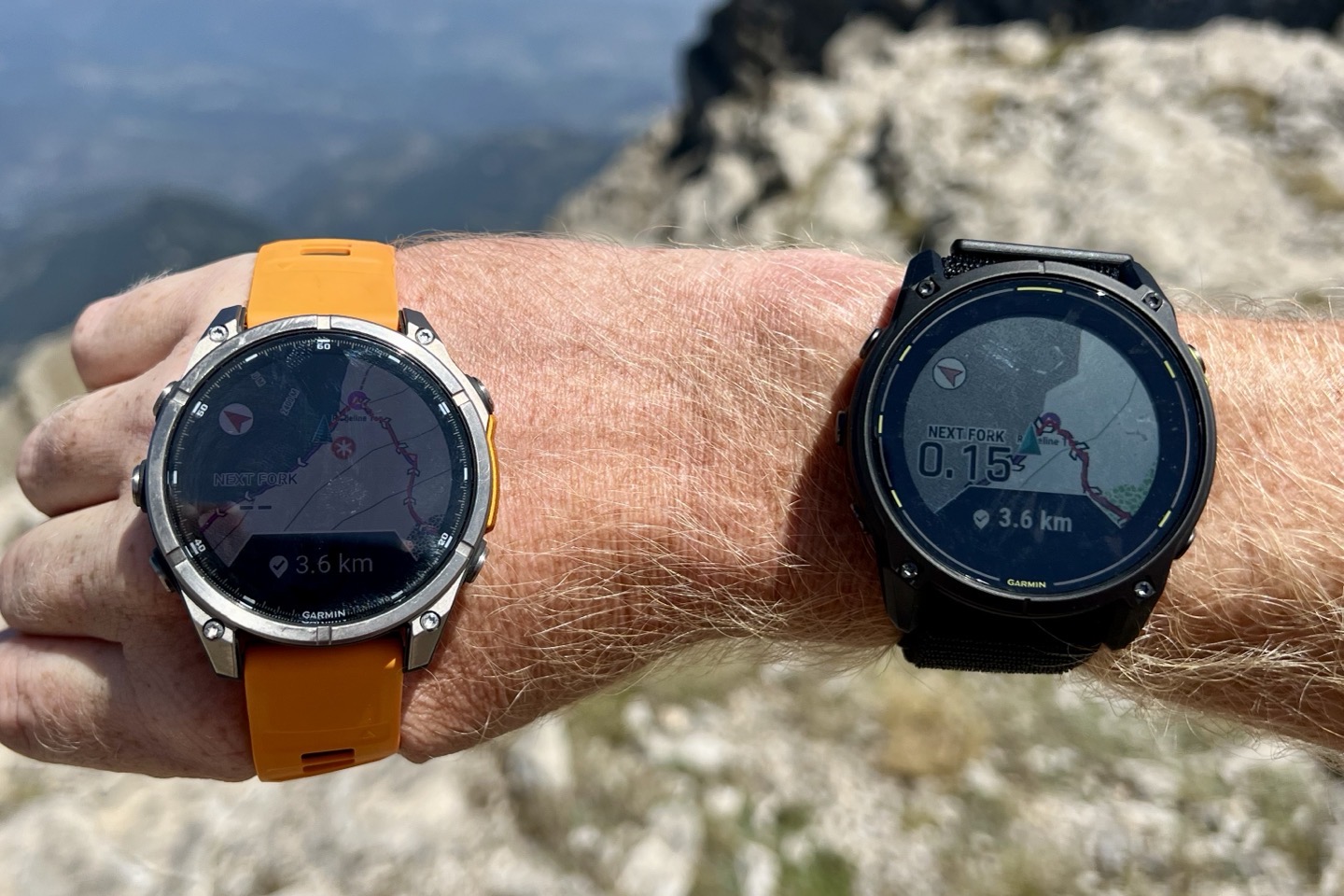
Nonetheless, let’s look at battery life across two key scenarios, On the first day of this hike, we had made a pact to try all the watches on the map view the entire time while hiking. Some of us did a better job at remembering that pact than others. In this case though, my Enduro 3 was set for GPS-Only (saves battery life), while Des’s was set for SatIQ (which can leverage multiband GPS when needed). Otherwise, we were identical with all our settings as defaults, and using optical HR.
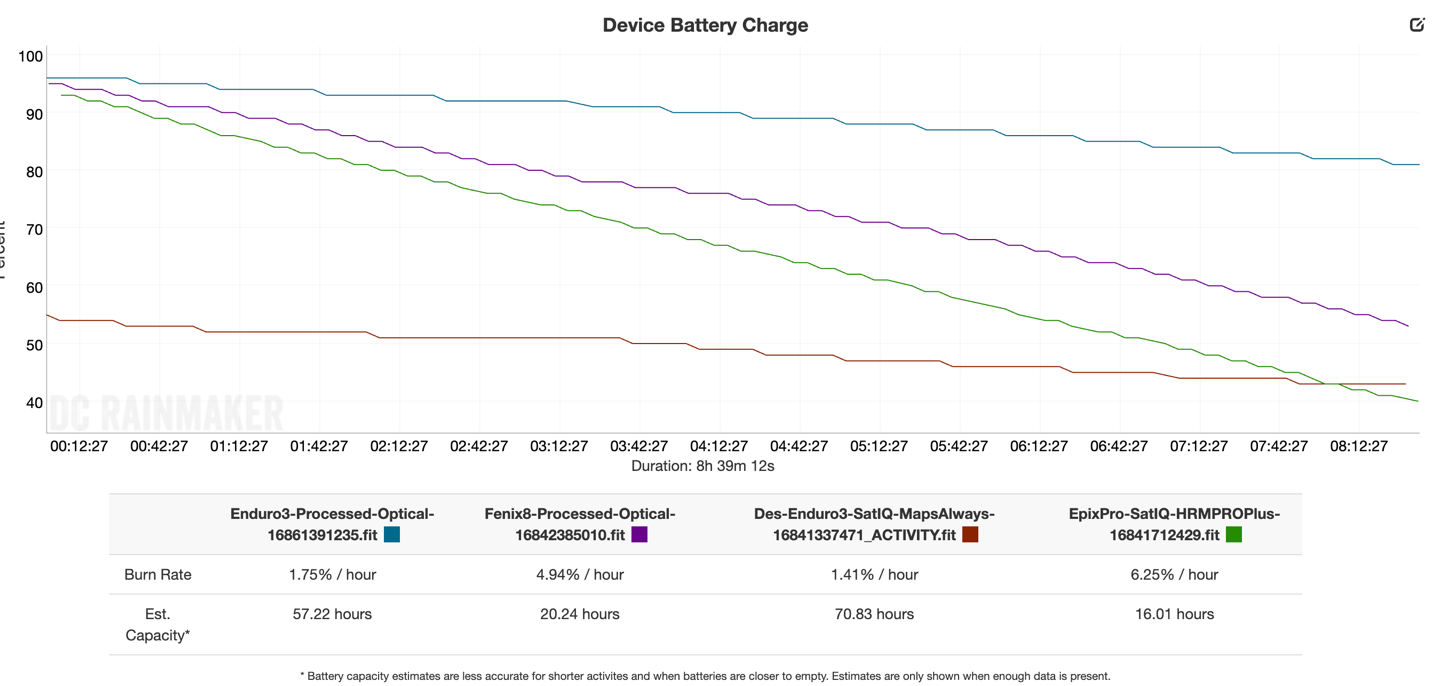
You can see here that leaving it on the map screen absolutely buried the battery life. You can also guess which one of us did a better job at remembering our map-only-page pact during those 8 hours of mountain trekking.
On paper, Garmin doesn’t have a ‘map-always’ claim on their battery charts. That said, for SatIQ, the claim is 72 hours without Solar, and Des rang in at 70.83 hours. Whereas with GPS-only the claim is 120 hours, but again that’s not leaving it actively navigating on the map page. I hit an estimate of 57.22 hours. Just to be clear, those are actual rivers of water below us on the ground:

The next day, while Des’s legs considered his poor life choices, I went out for another 10 hours of trekking. This time, I aimed to keep it on the ClimbPro page the entire time (or other low-update text page). I again kept it at GPS-only as I was further curious to see the impact of that on GPS accuracy, and how post-processing might fix that (see the next section). The Epix Pro, I left on the map page, cause much bushwhacking was to be had this day (still, unclear why that performed far below other days). Here’s that result, 38km and a lot of elevation:
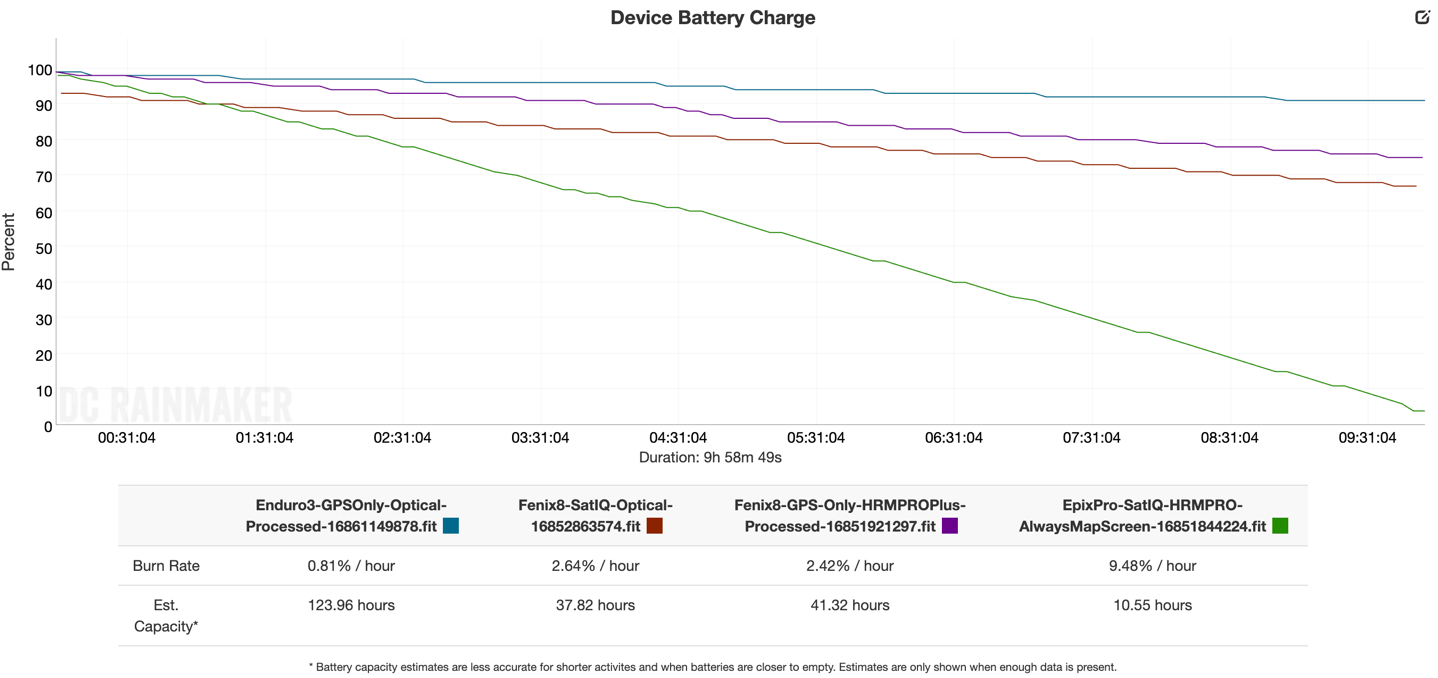
As you can see here, that 123.96 hour estimate is incredibly close to Garmin’s GPS-Only no-solar estimate. In my case, I had very strong sun during the day, but that’s counteracted by having navigation enabled. Still, it would see far from the 320 hours Garmin claims for GPS-Only with some 250K of solar lux hours (according the widget). Here were the conditions for probably 70% of the day:

In this case, I brought the data back to Garmin, and they said that the use of ClimbPro and other slow-updating text, but not plain text fields, was causing more battery burn than it should have. There will be an update in a few weeks to fix that. Thus, I’ll try again sometime in September.
Still, setting that aside, in a worst-case scenario here with GPS-only, we’re talking 120 hours of real-world battery life, assuming you don’t leave it on the map page. And with SatIQ, even leaving it on the page we’re talking
GPS Accuracy Testing:

Now, from an accuracy standpoint, I had two more questions. First, generally speaking, is the Enduro 3 accurate in a normal SatIQ scenario. And frankly, the answer to that is an easy yes. Here’s a quick city test, and you can see it’s spot on:
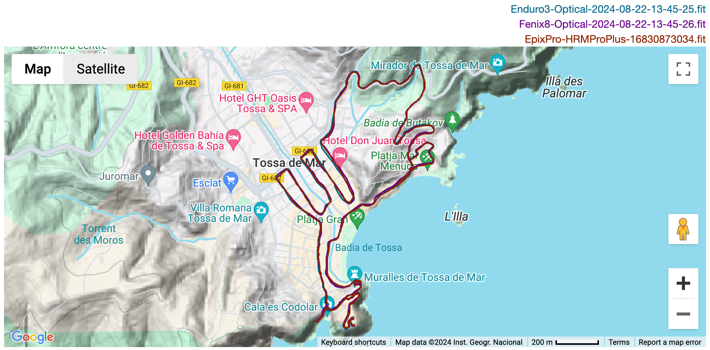

And of course, heart rate on the same sensor as the Fenix 8 and all my testing there is spot-on too (and the same sensor as the Epix Pro & Fenix 7 Pro):
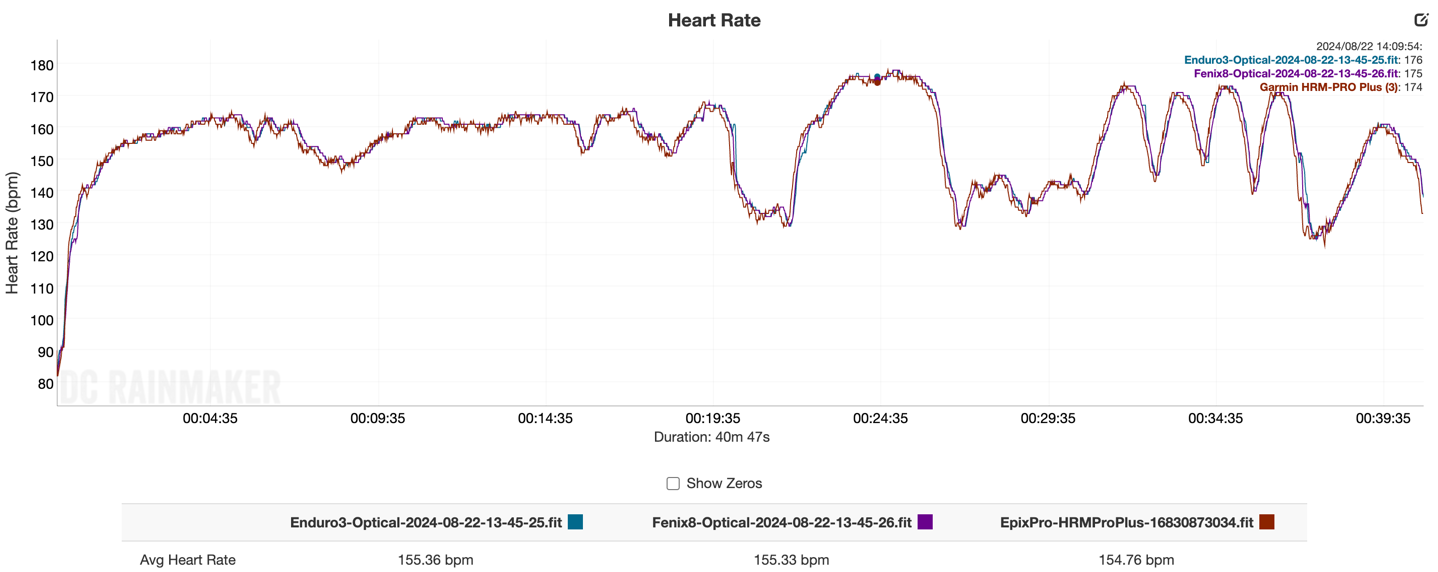
Again, I’ll add in more data sets later, but for now, let’s get to the next question:
If we really wanted that theoretical 320 hours of GPS battery life, is the GPS-only mode actually viable from an accuracy standpoint? Well, let’s take a look. Here we’ve got four watches:
– Me #1: Enduro 3 in GPS-only configuration (right wrist)
– Me #2: Fenix 8 in SatIQ configuration (left wrist)
– Me #3: Epix Pro in SatIQ configuration (left wrist)
– Des #1: Enduro 3 in SatIQ configuration
Across the entire day, we were rarely more than a few meters away from each other, and virtually always taking the same track. So here’s a climb through the forest of the four units:
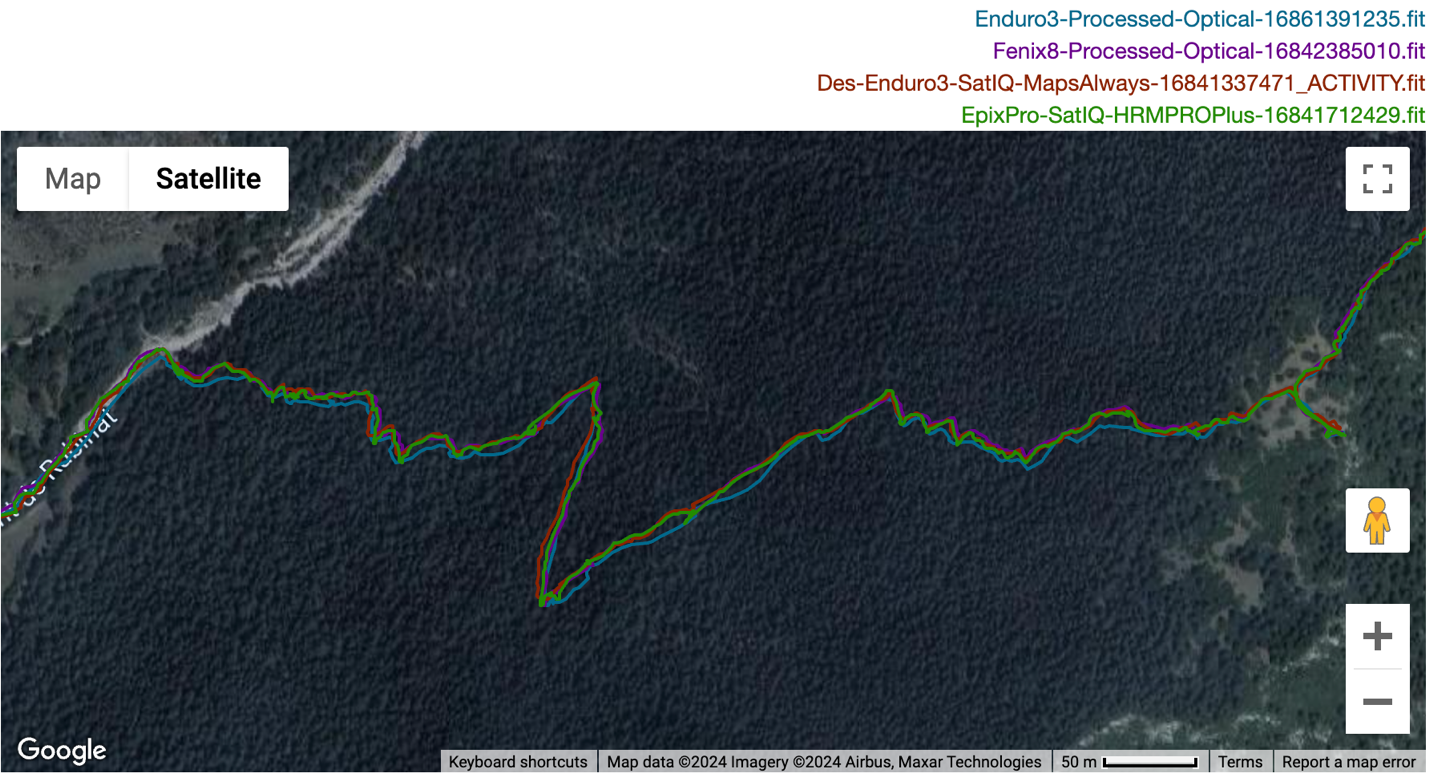
As you can see, there’s a little bit more wobble on my GPS-only track, but not a massive amount. It does lead to differences in distance though (more on that in a second).
However, on the descent next to steep cliffs, there’s almost no meaningful difference here:
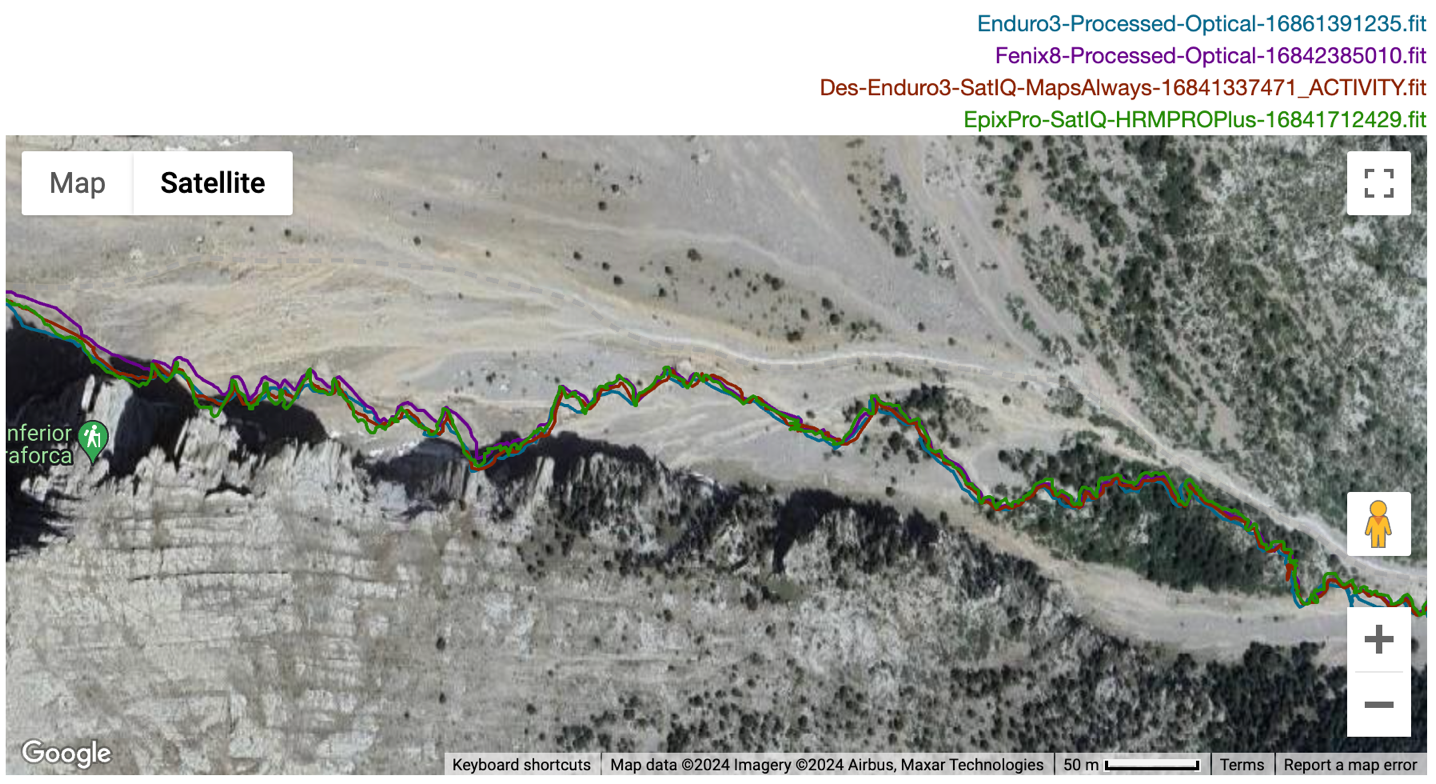
And at the end, on this hike, the stats were nearly identical for mileage totals:

However, the next day when solo, I’d see nearly 2km of distance difference by the end:

Yet again, on the whole, the GPS tracks looked great here:
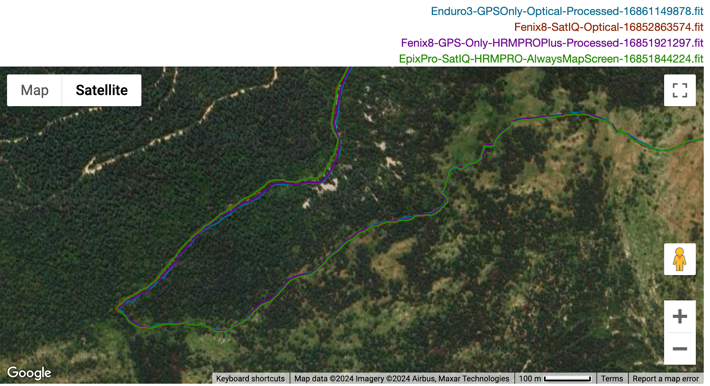
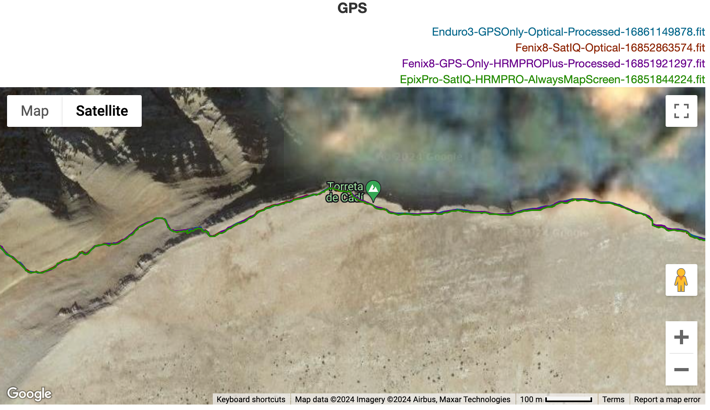
So that then gets to an even more fun question: How does Garmin’s new automatic track enhancement feature work?
This new feature on the Enduro 3 and Fenix 8 will automatically analyze and re-process for improved GPS accuracy, tracks which show signs of poor GPS conditions during the route. This won’t happen every time, but what happens when it gets flagged as a questionable GPS track? What changes?
Well, I’m going to look at this over a bunch more data sets, but for fun, here’s my hike’s Enduro 3 GPS file (in GPS-only mode) before and after that processing. In general, you’ll see very minor tweaks, but it seems to remove some of the more wonky twists/turns that show up in poor GPS signal scenarios.
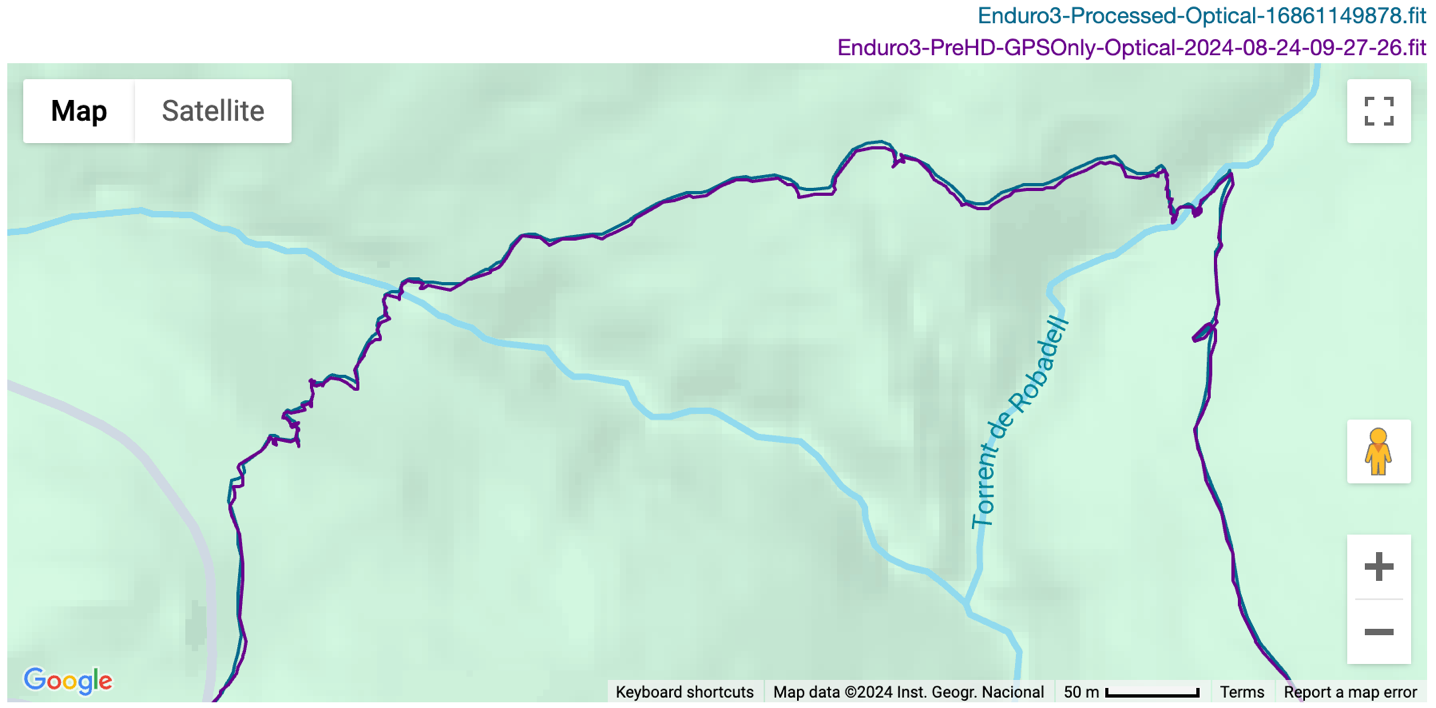
Again, I’ll dive into that in an upcoming post with more details on how that works (fear not, you can turn it off if you want).
Wrap-Up:
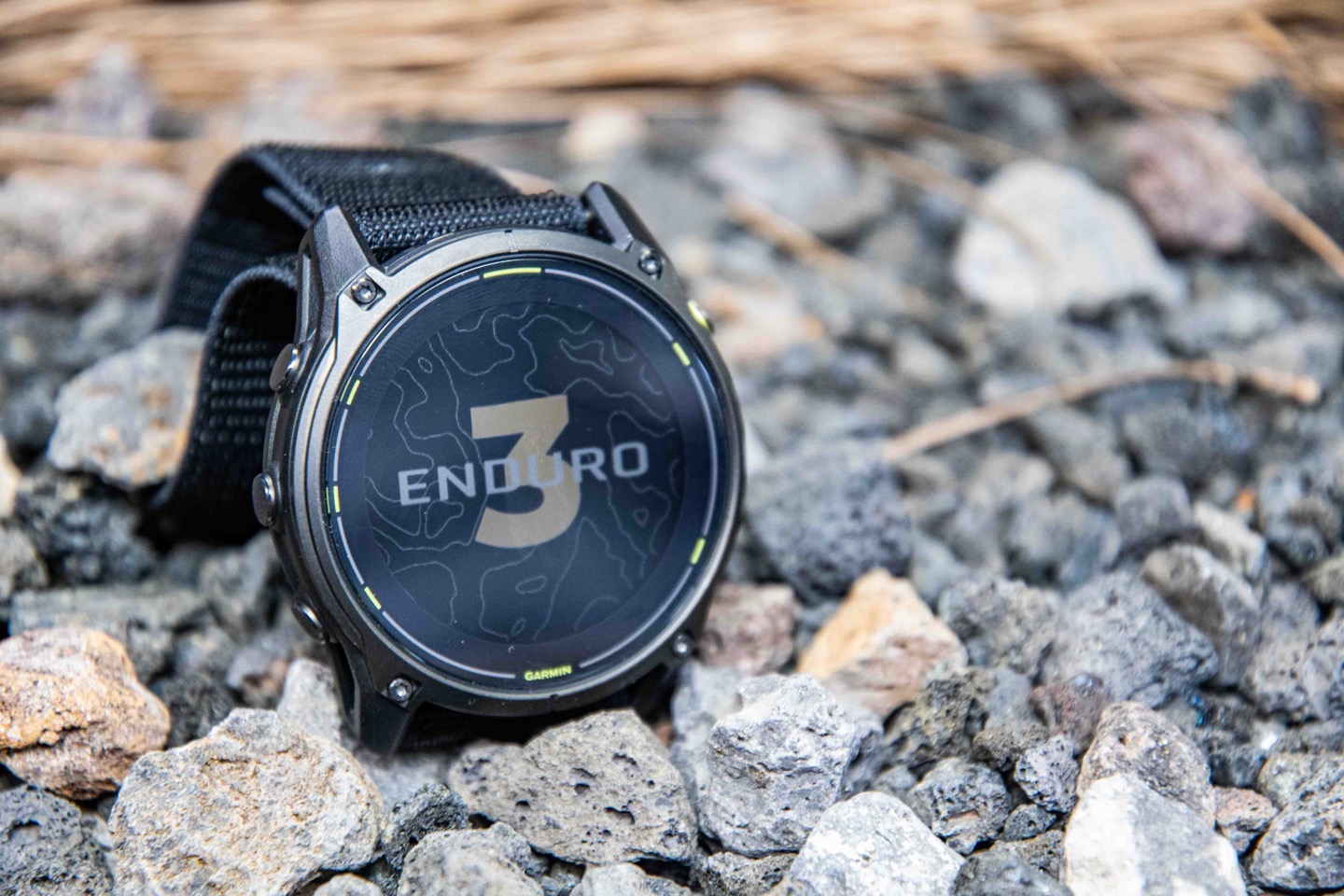
I wrote this entire post last night, up until this last section. Before I completed this section, I went and filmed my Enduro 3 review. And it was in my final 60 seconds of filming that unscripted video that I realized something: The Enduro 3 is ironically the solution to the overwhelming negative comments about the also new Fenix 8 Solar, specifically, the pricing.
With the Enduro 3, you lack the speaker/mic/diving that most MIP-owners don’t seem to care about. Yet you also magically lack the $300 price increase of the Fenix 8 MIP-based models (up to $1,099 from previously $799). All the while gaining better battery life than the Fenix 8 Solar, yet also keeping all the new user interface bits and features. Given Garmin has stated the new user interface and features won’t be going back to previous-gen models, the future of updates for the Fenix 7 series seems questionable right now. This solves that.
Sure, it doesn’t solve for everything – namely, people that don’t want a larger 51mm watch (like my wife, who wants a 42mm MIP option, such as her existing Fenix 7S Pro at 42mm). Or, the six MIP-based people that want a speaker/mic in their watches. But hey, for the thousands of others that expressed their frustrations yesterday in the comments section across both the site and YouTube, this epiphany moment might be a winner. Also, can we take a moment to appreciate Garmin actually reduced prices here (the Enduro 2 was $1,099, and now it’s $899).
But enough about pricing. In terms of all the other technical things, it worked well. I’m looking forward to testing out the upcoming firmware tweaks to the ClimbPro page battery bits, to see how much more I can eke out of it (and other non-map pages). Likewise, to see Garmin put a bit more polish on the current new user interface, namely in the speed realm, but also finish-up some sections like Focus Modes.
Overall though, if I was into larger MIP-based displays, then this would be the easy choice.
With that – thanks for reading!
Found This Post Useful? Support The Site!
Hopefully you found this review/post useful. At the end of the day, I’m an athlete just like you looking for the most detail possible on a new purchase – so my review is written from the standpoint of how I used the device. The reviews generally take a lot of hours to put together, so it’s a fair bit of work (and labor of love). As you probably noticed by looking below, I also take time to answer all the questions posted in the comments – and there’s quite a bit of detail in there as well.
If you're shopping for the Garmin Enduro 3 or any other accessory items, please consider using the affiliate links below! As an Amazon Associate I earn from qualifying purchases. It doesn’t cost you anything extra, but your purchases help support this website a lot.
Here's a few other variants or sibling products that are worth considering:
And finally, here’s a handy list of accessories that work well with this unit (and some that I showed in the review). Given the unit pairs with ANT+ & Bluetooth Smart sensors, you can use just about anything though.
And of course – you can always sign-up to be a DCR Supporter! That gets you an ad-free DCR, access to the DCR Shed Talkin' video series packed with behind the scenes tidbits...and it also makes you awesome. And being awesome is what it’s all about!
Thanks for reading! And as always, feel free to post comments or questions in the comments section below, I’ll be happy to try and answer them as quickly as possible. And lastly, if you felt this review was useful – I always appreciate feedback in the comments below. Thanks!




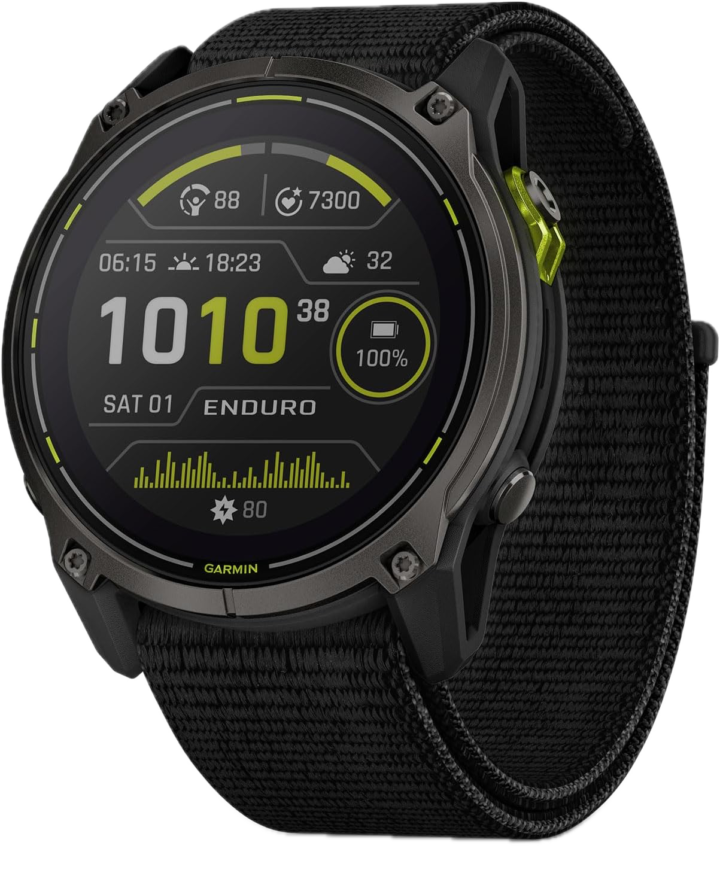
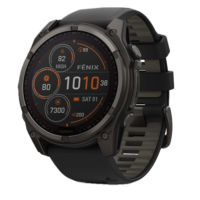
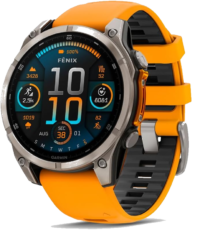
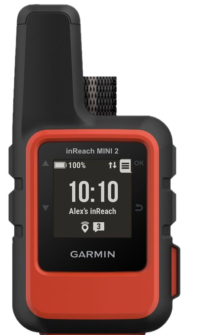
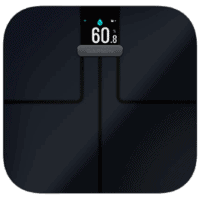
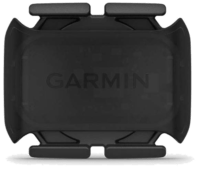
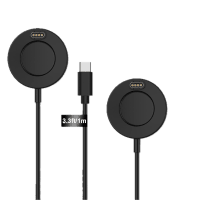
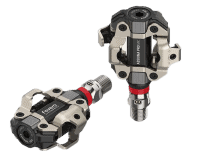
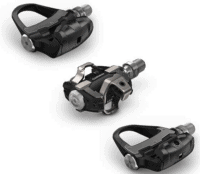
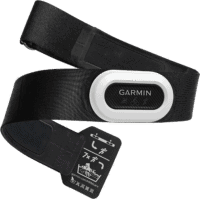



















I’ve spent 24hr refreshing waiting for this… have read the wrap up first, and am now hunting online for stock.
Feels like the perfect 955 upgrade for me – especially as I have also just pressed the button on my next 100 miler.
Top work Ray – Influencing at its best!
Awesome review! I’m a bit nervous about the 51mm on my dainty little wrist, but the watch has enough of a draw that I’m willing to pull the trigger and can always return it if it’s much too large.
It’s all about your attitude. I have friend who is a woman who is 4’10” that has a 51mm fenix and she pulls it off just fine.
Don’t worry. I’ve got pretty skinny wrists for a dude and have a Fenix 7XSS, which is also 51mm. It’s big, but more importantly it’s super readable in the hoof, precisely *because* it’s big. I do struggle to wear it in bed, though. I ended up buying an Ōura 4 to cover the sleep stuff.
Spot on Ray. Thanks. Garmin will sell a crapton of these.
Seems like by the next gen we’ll have Fenix as an AMOLED line and Enduro as the MIP line. It would be awesome to see a full size range of Enduros.
This does seem like a great watch at a fair price, but it feels like the next year model of a car rather than an actual successor to the Enduro 2. Just minor updates for the most part.
You think very similar to myself, when I was going through this review.
But even compared to my current Garmin Fenix 7 Sapphire Solar the “innovation” is limited for my usage scenarios.
If I would be hunting for a new watch, than this Enduro would be on my top-list. I’m curious to find out what will happen to the Instinct 2X line-up (which was also focused on outdoor use and extreme good battery-life)
I guess the Instinct series will keep on, as it is a different price target and different features. More rugged, no map, no music storage, black and white screen.
I can’t wait to see what battery life it will have if Garmin use that new solar panel :)
You mentioned your wife wanting a little MIP on the other review too, can you share why? You’ve been fairly consistently in favour of AMOLED screens from what I can remember so it’s interesting that she has a different opinion.
I was in the MIP camp until very recently when I realised there was a bug in my EPIX stopping always on from working, so as a watch it was hopeless. I still prefer the MIP as a watch (I still have the F7 too), but ordered the F8 AMOLED as it’s nicer in activity.
Love the approach with the reviews not copy/pasting the whole thing, easier to find the relevant parts to read.
Great review as always Ray!
Do you think we can expect any time soon a 47 mm of the Enduro 3?
Garmin, if you are reading this, make a 47 mm version of the Enduro 3 and I will give you my money inmediately
I’ll answer this one… No.
What you describe is, I think, the Fenix E. The reduce size resulting in the reduced battery.
Fenix E is AMOLED based, not MIP, neither solar, thus it’s not a 47mm of the Enduro 3 (The Fenix 8 47 mm Solar) has the microphone that I really don’t need and the dive features that I will hardly use and cost quite a lot more
Yes – very fair! But I still think the answer is no!
I can’t really figure out purpose of the Fenix E. Is it just a mid-size Epix 2 Pro with the Fenix 8 UI updates?
It’s actually more similar to the original Epix 2, not the pro.
I asked this exact question to Garmin and they responded that the differences are all software based, the hardware is essentially the same as Epix 2 (non-pro) other than of course the revised aesthetics.
This is why I picked up a 47mm Fenix 7 Pro Solar on sale earlier this year – you probably don’t actually need more battery life than that. It handled my (almost) 13hr trail race easily. I charge it, at most, once a week when doing 1-3hr activities every day. Unless you need GPS on for multiple days at a time, you don’t need the Enduro (and if that’s truly what you need it for, the Enduro’s size shouldn’t matter).
Count me in as a buyer when the 47mm comes out! Until then, my F6 Pro will continue to do the trick.
I would say, this is for some users, me included, the (almost) perfect Garmin in the world. For me, all this above with amoled for that price would be 100% spot on. But you can’t get everything in life, can’t you? It will be a perfect upgrade or my good ol’ fenix 6. (Now I need to save up some spare money)
Interesting take on things- and very much accurate.
The Enduro 3 seems to be the obvious choice for people that want a 51mm watch and want/don’t mind a MIP display. It is kinda crazy the MSRP is that much lower too!
Personally, I am keeping my Fenix 8 51mm Amoled order in place, can’t go back to that display type after getting totally spoiled by my AW Ultra 2 and the Epix Pro 51mm.
Enduro 3 looks as cheap Forerunner. Back is not titan, this is very weak move Garmin.
Honestly though, the a titanium back is just for looks, and does add substantial unnecessary weight. It doesn’t serve any real purpose, the back of the watch is the least likely part of your watch to take damage.
What does a titanium back *do*? Strap attachment ears break. Backs don’t. The titanium back is all show, no go.
…and not even show…it’s just a snob factor:)
I was waiting for an update to the Fenix 6 and this seems to be it. perhaps a bit bigger but does everything I want. I don’t want to be on the phone when I am out on a run or on the bike.
I am kinda puzzled if now we have arrows when navigating the course indicating which way the course is going, instead of just a plain line. This picture seems to indicate that’s correct, but could someone confirm?: link to media.dcrainmaker.com
Yup, they were added a year or two ago.
Thanks, I appreciate the reply
There’s arrows and then there’s the cursed Pacer triangle.
Hi Ray
Will the Enduro 2 now receive an update to some of the new updates on the Enduro 3
No plans to push any new Enduro 3 or Fenix 8 updates to previous models (at least, Outdoor models, I don’t know about Forerunner units).
Does it have a flashlight?
Agreed with comment nr 1, might be a good follow-up to 955. F8 seems pointless without LTE, but I’m guessing the LTE-version will be the next to be announced…
Yes it has a flashlight
Great review, as ever (love the rain).
On the “automatic track enhancement feature” – does this happen on the fly or only after you end the activity? It is of much less utility in the latter case as you still have the errors in the distance to your next waypoint when out in the field…
Many thanks
Chris
Only afterwards.
But distance to next waypoint is calculated on your current position, not historical position. And in that scenario, we’re rarely talking more than a few dozen meters in the absolute worst case GPS in-accuracy.
Agree, looking when my fenix 6 pro expires this is the direction, I want a rugged watch and already turned off its smart watch features,currently have a time, date, battery % display. Why would I want to speak to a watch and still have to carry a phone?
Could see potential in an accident situation but already has alert for that.
Question, weight saving is the case more plastic than metal of f8 ? Prefered the weight of the fenix v forerunner watches, came from tag heuer watch.
Funny enough, with the reduced pricing on the 3, you can currently still buy the older Enduro 2 for $100 more than the new Enduro 3 (in the US at least)
link to garmin.com
link to garmin.com
Quick typo..
“First, generally speaking, is the Enduro 3 accurate in a normal SatIQ scenario. And frankly, the answer to that is an easy.”
Assume you want a YES at the end of that…
With regards to the new UI. When I run with a map, I usually have elevation and map following the normal data screens and can flip between them. Is this still possible without having to move ‘sideways’ and click into the nav data swim lane?
Is it possible to zoom the elevation profile page yet? That infuriates me on a long route – its very hard to see how close you actually are to a climb when the profile is showing the whole plot (maybe I need to work out how to actually use Climb Pro?!)
How does the new UI work when touch is disabled?
Finally…
Nothing really that pushes you to upgrade from an E2 though…., from that place, this is evolutionary not revolutionary
Sorry – remembered another one… What size if the band and I assume there are quick fit type ones available?
Per specs on the Garmin page, it is Quickfit 26mm compatible
Garmin made a choice in creating a theme you can’t change anymore on the fenix 7 and it seems the enduro and fenix 8 have the same theme. It seems they did not test with MIP displays with backlight off.
I also saw in the video (enduro or fenix 8) there still is no option to hide map poi (only user) and labels (like street names), the text and poi can hide entire streets..
I use my map north up all the time, so not so much battery drain when using the map all the time for me ;-)
This watch looks like a fantastic option for many people! It unfortunately doesn’t fit my own personal wants/needs (namely, the fact that I just can’t go back to MIP now that I’ve been using an Epix Pro for so long), but overall this looks like both a great watch, and that price is shockingly fair.
Can the North Up toggle be used without touch? Can you change the “lanes” without touch?
On the lanes… Looks like yes from other videos. Shortcut middle button for the left lane (like you would yo get to settings), and down for music (same as the shortcut I currently have for that)
Does anybody know if the build (metal,buttons) are the same as the Fenix 8 MIP? If so, I dont understand the difference of this one with the other
The Fenix 8 buttons are dive-rated, “leak proof” with an inductive design instead of mechanically penetrating the case. The Enduro 3 just has the standard buttons, like we’ve had on previous enduro/fenix watches.
Also yes the case and bezel are different. Solid plastic case with the back molded in, instead of a metal back. Front bezel substantially reduced in size/thickness to reduce weight.
This seems to be the most sensible watch Garmin released this time. However, it’s a real shame that there isn’t a single SKU that has MIP and a non-sapphire lens. The problem with sapphire is that it is so reflective that on overcast days all you see is the reflection of the sky. The backlight on 100% helps somewhat but I’d always choose a regular lens over sapphire because of that. I ended up trading a Fenix 7SS for an instinct 2x because it’s actually readable but I do miss some of the features. I guess all the complaints about MIP being too dim have more to do with the sapphire than with the display technology. The difference between my old Fenix 6 (regular) and the 7SS was like night and day.
He-he, I typed my comment almost for an hour, so when I started your post had not been born. I fully agree with you!
Agree, I had to turn on the backlight by hand movement on my 7 Pro, because in many situations it is much worse to see than on my previous 6 with a regular glass (one day I even specially wore them at the same time to understand what was going on)
But wrist gesture backlight doesn’t work well when trail running. When enabled, it ends up being turned on most of the time, especially when running downhill. That has been my experience with Fenix 7X SS. So on one hand it is absolutely necessary to improve map readability, on the other hand the battery gets seriously affected – my watch ends up using twice as much battery vs not having wrist gesture backlight.
I one if the ambient light sensor at least helps to reduce the backlight usage when used together with wrist gesture?
I wonder if there are any other changes from Enduro 2 to 3 that are worth noting.
Button changes, flashlight changes, MAH value on battery.
You and Des are living your best life out there! Do you know if the GPS chipset has been updated, or is it the same Airoha AG3335M chipset?
It seems that Quectel might be the developer of the GNSS module. link to quectel.com There don’t appear to be any updates to this module in the last couple of years. So, I suppose if Garmin didn’t change chipsets, its still the same module.
My understanding is that it’s the same.
But it seems that something changed like the reduced GPS Drift.
If you don’t move during GPS tracking the Epix Pro / Fenix 7 saw you moving but not the old Fenix 6x or the new Fenix 8
“Removed transparent solar panel across surface of display (increasing visibility)”
This is what I wanted, but did not joed for after seeing the label Solar.
Do you have any knowledge or just a bet why Garmin does not offer Gorilla, just Sapphire?
Applying Sapphire is some sort of (partly) taking back of what the ommission of full Solar layer gives in terms of clarity/visibility.
I still regard the readibility of Fenix 6X pro, non-solar, non-sapphire as minimum of MIP displays
joed=hoped
I really appreciate the scratch resistance of sapphire. I’ve got a seiko watch with a sapphire lens, wore it daily for decades without a scratch. My Garmin device with a sapphire lenses has no scratches, either. I will stick with sapphire lenses until something better shows up.
Sure, you prefer scratch resistance. I spoke about clarity.
Unfortunately I have no exact data about how much the solar layer has “stolen” from clarity for all those Solar versions of F6, F7 and Enduro 1/2, and how much the Sapphire has “stolen” from the Sapphire version.
I just wondered whether Ray got an explanation from Garmin considering that CLARITY was a focus for Garmin in case of Enduro 3.
It seems he did not. Or he just missed my comment.
Maybe it is the answer to the question of how much effect of sapphire has on clarity and how much of solar.
“Regarding screen clarity, yes, that too seems clearer to me. I wouldn’t describe it as massively clearer, but slightly clearer:”
I mean both Enduro 2 and Enduro 3 have sapphire, but only Enduro 2 has a solar layer over the full surface of the display area.
Gorilla Glass 3 is extremely scratch resistant as well. Never had any problems with any of my Forerunners that use Gorilla Glass 3.
I agree with the notion of missing the non-Sapphire option.
Though, if you regard the 6X Pro non-solar non-sapphire as the minimum, then you could consider the 15-month old 7X Pro Solar non-sapphire as a viable update. Garmin did some improvements on the 7X Pro model’s MIP display and Solar layer, which made the screen similar to 6X Pro under natural light, and more contrasty with the backlight on.
Comparison in natural light, 6X Pro vs 7X Pro Solar, both non-sapphire: link to i.imgur.com
“Do you have any knowledge or just a bet why Garmin does not offer Gorilla, just Sapphire?”
I was thinking a lot and finally I myself arrived at a bet. All the 3 size versions of F8 Amoled has Gorilla glass sub-versions, and also F8 E comes with Gorilla, but none of the F8 Solar versions.
So together with Enduro 3 (Solar) we can say that Garmin offers Solar only together with Sapphire.
In other words it seems that Garmin does not insist on Sapphire just to save the display of high-end, expensive watches, but it must be for some technological reasons connected to the new solar panel approach.
I dont think it is about to achieve economics of scale, otherwise F8 Amoled would come only with one display lens.
Thanks for the photo sikaheimo, it helped me a lot.
Do you have a comparison photo on these two watches, but with white background and black fonts?
nice watch, nice screen, not that many decent feature upgrades from the 7… and the prices are now just too high.. I’m just not going to pay that much for a watch, Garmin Support here in New Zealand is not good, the nearest support center is in australia… i know people who have had big issues with getting faulty watches sorted, having to haggle a price for a reconditioned watch, i hear coros are more no questions asked replacement…. get a titanium watch with a saphire screen for hundreds less than a garmin,, yeah it may not have the features but its a fitness tracker with fancy features and how much do i really need them>? i dont want to have to argue with garmin if my expensive watch fails on me. a watch is a watch, they can break, then what? its just too much money to spend. garmin seem to be catering to the higher end of the market now, want more features then you can pay for it…. coros standardise their software better across their range… and you get better battery life without having to pay through the nose…
After years of using Fenix models I have now ordered an Enduro 3. Don’t need the dive functions and I don’t care about the microphone etc. Amoled is nice to have but I prefer the battery life. So, a no brainer.
Great review as always. I can’t help but think maybe it is time to start using products from other companies like Suunto, Polar or Coros. Garmin makes amazing products, but man they are trying to be everything to everyone with what could be considered pointless integrations for athletes and they are shameless with pricing. I’m a little afraid to start this discussion because I don’t want to be flamed by Garmin fan-boys and girls, but would be curious how people feel moving away from Garmin in the last year or two feel about their new devices and whether they regret it.
I agree. There was a time when you basically bought a Fenix because it was the same price as the top watches from other bands, while having some cool tricks that no one else had. But now we are getting into very specific things (eg. Diving, a week long GPS activity, etc) that for most people cant justify the price increase. Fortunately I don’t need to upgrade anytime soon, having bought a heavily discounted Epix II.
The thing is, Garmin still sells way cheaper watches that do way more than the flagship watches from other brands, and at a lower price. The main difference is that you don’t get the premium materials and look of a flagship watch if you go with a Forerunner….But there’s a solution for that too: Just get an older Fenix, and you’ve still got a more capable watch than any of the others have made.
Look, I wish that the other brands were more competitive, but they just aren’t.
I have used the Epix and. the Fenix 7X. I think they are great watches that do everything you need to be serious with sport.
Hi! Though I have to admit that I am not interested in diving or smartwatch features, I‘ll stay with Garmin since they offer a working eco system and are able to provide a lot of data. I also like their flawless navigation features. And-they also connect flawlessly to all my sensors. Thus, for the foreseeable future I‘ll stick to my trusty F7solar. Cheers!
JR: I’ve always said the value is in the older/used Fenix models, which Garmin has added new features for several years (3-4 in case of F6 series).
But now with the F8/E3 built on new code architecture, the support (new features) to older watches basically stops here, according to Ray’s direct quote under the F8 review comment section.
Sure, the watch won’t get any worse due to no new features added. But it changes the value calculation somewhat.
Agree. I use my sports watch only for my sports, putting it on just before e.g. running and taking it off afterwards.
Your remark is spot-on: “they are trying to be everything to everyone”. Then they risk to be not sports watches, but rather smart watches with a lot of sports functionality.
Fine if you’re looking for that, but I am not. And then I think other brands are interesting too, like Suunto or Polar. I hope they stick to making sports-only watches.
You do you, but by only using a modern Garmin for tracking GPS & HR during sports, and then turning it off, you’re losing a large chunk of sports-related data – recovery, HRV, how training impacts sleep, and so on.
Hi Iustin, I’m sure you can take your watch off after your workouts – and even get less fuzzy, abracadabra data.
Formulas to calculate Training Readiness, Recovery Time or Training Status are not well scientifically substantiated, to say the least. My five cents: when they are really wrong, they might even be dangerous to use to steer training efforts.
With that, guessing the ‘sleep phase’ goes often wrong, as Ray often states, so using that in formulas is strange I’d say. The ‘time in a certain sleep phase’ is however used all over the place.
Don’t get me wrong, some source data might be helpful, if interpreted well. I am for example thinking on HRV data at night. But I don’t have any proof, like white paper or anything else, that the Garmin formulas interpret it useful. And not only me. I have to add that that was different when Garmin worked together with Firstbeat, that was solid. Not these scores they provide you with now.
And don’t get me wrong, I do like Garmin watches. They are good. Just don’t “believe” to much in things like Training Readiness, Recovery Time or Training Status.
Interesting. I do not care so much about having scientifically validated training formulas, but I’m looking almost exclusively at the raw data. For the past 4 years, Garmin’s stress and sleep data correlates quite well with my actual state, so much so that I can rely on simply the visual graph of stress to know when I’m pushing too hard and when not.
Separately from sports, unexpected high stress has let me know twice in advance of getting sick. And sleep data, for me, works quite well – I know that low REM will correlated quite well with lack of mental bandwidth (for intellectual tasks), for example.
I’d rather have incomplete or not fully correct data, than have no data because it’s not perfect. As I said before, to each his own.
Stress data (HRV) seems indeed very useful to me too. I measure it when waking up (I use HRV 4 Training instead of wearing a sports watch all night), and I experiment a bit with HRV when running (several experimental tools).
But I don’t see a need to wear the sports watch all day. I prefer to wear other, ‘normal’ watches. I have several of them, not too expensive, to match my clothes/mood/wathever.
So I did do some research on the benefit of wearing a sports watch all day but did not find a compelling reason to do so.
On the other hand, I don’t see a reason to not wear the Garmin all day if you want it.
One last thing, you write: “I’d rather have incomplete or not fully correct data, than have no data because it’s not perfect.” . I prefer “Better to have no information than false information.”
Incorrect data can be more damaging than having no data because it can create false confidence in wrong conclusions. But indeed to each his own, your focus on the raw data might help here.
Thanks for your posts by the way. I don’t see much discussions & information on actually using data and advise from sports watches. Your comment about stress levels and detecting getting sick is very interesitng.
Believe I will be moving from the Fenix 7 Solar Pro to the Enduro 3.
“Or, the six MIP-based people that want a speaker/mic in their watches. ”
LOL, this is me. I want the enduro 3 with a speaker and mic!
Thanks for the review
This is really tempting. Offers everything most people really want and a good price point. But… I like the lightness of a forerunner so I think I’ll just have to be strong willed and hold out until next spring for a 975.
I’m a runner with a 955 and like the light weight. I had a F3, but it was too bulky. I think I’ll be getting an Enduro 3. The weight jump from the forerunner isn’t significant, the wider strap should help too, and I love the reduced bezel look. Reminds me of the clean look of a Suunto. Nothing not to love here!
My 955 should still fetch reasonable resale value too, and that will likely drop quite a bit waiting for a 975.
Very interesting. Indeed, if I wanted to upgrade from F7X, this would be it, not the F8X/Solar. But so far, this generation, Enduro 3 included, is not quite worth the cost for upgrading.
I guess, one day I’ll have to try an AMOLED watch. But so far, what I see at colleagues (usually AWs of various types) is not really appealing (to me).
Note that the actual battery promise for Enduro 3 seems to be 90h according to the table if you want the best accuracy. And that likely is what you want.
That depends… I think most people would just go with Sat IQ and leave it at that. However, 90hrs is huge and not many people will do 90hr + events without charging! So in reality if you’re *really* anal about GPS then you’re probably right, but most people aren’t.
The big appeal here for me is 22hrs with music. I train with music and generally race without. However, in the final 20% of an ultra I may want some tunes. The battery here means I’ll never have to worry about charging, even if I do the whole second half of a 100 miler singing along to Taylor.
Should I wait for Ultra 3? Or go for Epix 2 (half the price) or Enduro 3. Just sold my Fenix 6.
I’ve been waiting for this one after the disappointment, I mean, release of the Fenix 8 yesterday. I’ve had the 6s forever and have been waiting for this day for what seems like forever as well just to find features I didn’t want and lack luster improvement for battery in a small formfactor. I didn’t want a speaker/mic, I didn’t want AMOLED, I wanted the 6s with more battery. haha.
ANYWAY – seems your wife is in a similar boat – curious what she is wearing and if she’s planning on just sending it and wearing the chonk? I’ve got my first 100 miler this year and sadly I don’t think the 6s can do it.
I’m in the same boat – I love my 6S, but just smashed the glass face this weekend. I don’t care about diving features, so the Enduro 3 looks like it’s my jam except it only comes in one size. What’s a small waisted gal to do???
Thanks for this DC. Your assessments are essential for the outdoor community
Hi Ray,
you wrote:
„ First though, let’s dig into exactly how the Enduro 3 differs from an Enduro 2:
– Added new Garmin Elevate Gen5 Optical HR sensor“
Is it really the Gen5 sensor?
Yes. One can visibly see it’s the Gen5 sensor, aside from Garmin also saying as such.
My bad. Confused it with Fenix E
Well done! Thank you for the detailed and helpful review. I am looking forward to seeing how the navigation UI evolves. Decided to pick one up.
thanks
Hi!
Is the user interface faster than Fenix 8? Especially in cpu-demanding situation like map scrolling?
And has something changed regarding the touchscreen? Better, worse same?
For me, a Fenix 8x user, this is the next watch.
Thank’s for your work!!
It’s a bit faster than the Fenix 8 in my testing. Both are still a bit sluggish in places. I get the impression they haven’t yet got to speed optimizations on the new UI yet.
It would be nice if Garmin be more transparent about the hardware in their watches, providing specifics of the processor, GPS antenna, and display. It’s not clear to me whether these things differ, and if so, how, between the Fenix 7 Pro, Fenix 8, and Enduro 3.
Thank you Ray for both Enduro 3 and Fenix 8 reviews. I have been using Fenix 7S Solar since it’s release. I was really looking forward to buy the new Fenix 8 47mm MIP before I learned about the huge price increase. Now Enduro 3 seems like much better value for money – even though it would be too big for my wrist and I would actually like to have the mic and speaker from Fenix 8.
But for the time being, I think I will cool off for a while and see how the prices and features develop.
Is there any information about the CPU? Is there a newer one in Enduro 3 and Fenix 8? Or Enduro 3 uses old one from F7/F7 Pro and Fenix 8 has something newer for voice recognition?
So, Fenix E is the AMOLED Enduro 3, without microphone/speaker/dive features, right? And without solar.
I guess in future they could make Enduro as the MIP line and Fenix as the AMOLED.
Sorta.
The Fenix E is simply an Epix 47mm Gen2 (not-Pro), but with the new Fenix 8 software features.
No mic, no speaker, no dive, no flashlight, no ECG (Gen5 sensor), smaller storage (16GB vs 32GB). Also, overpriced.
With the enduro 3 being kinda Fenix 7X pro with the Fenix 8 software, perhaps the 7 series hardware could take it? Or this is where they draw a line in the sand.
Being a Fenix 7 user, I wonder how software update with new feature will be with the addition of the new 8 series.
Got it. Thanks.
I think Fenix E misses the mark by skipping the flashlight and Elevate 5 sensor. And the price is debateable too. Otherwise, it could have been a sensible buy (for many who want AMOLED) just like the Enduro 3.
I have used a Fenix 3 HR before and now a Fenix 7, but in between I owned a Venu 2 (which I passed on to my brother). I would love to have an AMOLED watch next at a sensible price.
Would there be any option to compare battery life of this one with Suunto Vertical? They look similar, at least on paper
I’d really love to see the rolling pin make a comeback! Did you leave it in Paris? (if so… I shudder to think how you roll out your pastry!).
It would be great to see a comparison of Enduro and F8 sizes, alongside a few forerunners etc. Not just for size, but bezel width etc too.
There arent that many online reviewers (that I trust and bother with!) who have access to ALL the devices. I think those comparisons would drive a reasonable amount of traffic your way.
I own Enduro 2 and I am not sure if upgrade to 3 is really necessary… what do you think?
Now that the MIP Fenix 8s is nowhere to be seen, let’s hope they will make Enduro 3s 😁
Inconsistency in battery life claims
Just as a simple comparison I checked what Garmin has been claiming about the extra effect of Solar in smartwatch mode as regards the different generations of Enduro.
Enduro (1): upto 50 days (65 days w/ solar) => 15 extra days or 30% extra time.
Enduro 2 : upto 34 days (46 days w/ solar) => 12 extra days or appr. 35%.
Enduro 3 : upto 36 days (90 days w/ solar) => 54 extra days or 150%.
Conclusion: the solar is 5 times more effective (vs Enduro) or appr. 4 times (vs Enduro 2). If you just count the extra days, it is 3.67-4.5 times more effective.
Another statement:
first from the review: “And atop that (literally), they revamped the solar display to be 120% more powerful, and improved the display clarity by concurrently removing the majority of the solar panel surface”
and as Garmin phrased it: “The larger, more efficient solar lens provides more than double the solar power of the previous Enduro model”
Sorry to say, but I feel Garmin does not even know what they are bluffing as part of their marketing game.
Not sure I follow. The solar gains are pretty straightforward, and you can clearly see the doubling in the GPS-only claimed specs.
Keep in mind that solar gains, and concurrently, battery consumption, are not equal across all modes. Some modes are more battery heavy, and thus in the incoming gains aren’t going to offset as well as other modes (ala GPS only).
The other thing is that the watch features/functions fundamentally changed in 24×7 mode. Things like wrist temp tracking, maps, music, etc… were all not there in V1 (and some still note there in V2). It’s effectively the same lesson COROS recently learned with their COROS Vertix 2S, as they turn on more health/etc features to proper/high-fidelity standards, then battery consumption increases.
“ The other thing is that the watch features/functions fundamentally changed in 24×7 mode. ”
Sure, I kept it in mind when I wrote my simple calculation.
It is why I do not focus only on battery time gains in just absolute terms, but also in relative terms.
If you have E2 and Solar(E2) and the latter gives a battery time of extra 35%, then using Solar(E2) with E3 would give the same extra of 35% (but obviously different amount of extra days).
But E3 has not Solar(E2), but Solar(E3), which is 120% more powerful (so you have to multiply by 220%), therefore the extra should be around 77%.
And Garmin says no, it gives not an extra of 77% (appr 27-28 hours), but 150%, that is 54 extra hours.
I hope I can be followed. It is like marketing guys used the magic doubling card twice. :-)
And just to make it clear I said nothing about the consumption and battery time while using GPS/GNSS, because it was not which was suspicius to me, but the smart watch mode battery claims.
But if you think that my logics fail, because one has to focus on absolute battery time gains, then you have to sell yourself the jump from 12 extra days (Enduro 2) to 54 extra days (Enduro 3), which is almost the same case.
12*220%=26.4, so that would be the extra days for Enduro 3.
But no, Garmin found the doubling magic card in the pack and used it.
“The other thing is that the watch features/functions fundamentally changed in 24×7 mode.” I have the Enduro 2 right now – Does Enduro 3 have higher-fidelity metric tracking? Wrist temperature is cool, but is there evidence that Gen 5 Elevate is objectively better than Gen 4? Or, is this comment suggesting they’ve found less battery drain with this sensor?
It includes wrist temperature tracking at night, which the Enduro 1/2 didn’t have. I agree, it’s not a huge thing.
In that comment, I was mostly referring to the other features that are enabled (some sport/gps features like maps/etc, some not), that increase that battery burn.
Gen 5 is slightly better in my testing than Gen 4, but not massively so.
You are saying that the 320h range claim during a GPS-only activity is satisfied with 50,000 lux conditions for 3 out of every 24 hours?
I just don’t think that can possibly right.
I think the 3 hours of 50,000 lux claim is only for the first * which applies to Smartwatch and Expedition modes. And I think Garmin puts these claims together in a way that is both technically true and totally misleading.
I have noticed that with the 7/Enuro 2 and 8/Enduor 3 solar series they have ** (and ***) claims which apply to normal GNSS activities. These ones *DO NOT* say 3 hours per day but rather only say “assuming use in 50,000 lux conditions”.
I think “assuming use in 50,000 lux conditions” is doing a lot of work because the range claims only work out in an idealized scenario of 50,000 lux conditions for the ENTIRE activity. That means no forrest, no clouds, no rain, no twilight, and no night.
To be clear, in fact, I believe this is a synthetic claim that cannot be reached under any race conditions on earth. I do not believe there is any realistic scenario in which you could get a lot more than 120 hours of range on a single non-stop activity on a single charge in natural lighting even in the most favorable conditions on the enduro 2. Maybe a bonus 5-10 hours. Maybe.
In reality you can get a small but unpredictable amount of extended range from the solar.
This parsing of the 50,000 lux conditions for the entire activity matches my real-world experience with the fenix 7X and enduro 2.
If I am correct in my interpretation, the claims that Garmin has been making about solar glass in the fenix and enduro for years are carefully misleading because under no real-word conditions can you achieve anything close
to the “with solar” range claim in a single non-stop activity. The truth is that solar glass is a nice but small bonus feature in real world conditions, not a game changer that adds 1.5, 2, or 3x the range.
I’d love to be wrong but I don’t think so.
Here are the claims with the *, **, and *** from Garmin for the Enduro 3.
Smartwatch: Up to 36 days/90 days with solar*
Battery Saver Watch Mode: Up to 92 days/unlimited with solar*
GPS Only: Up to 120 hours/320 hours with solar**
All Satellte Systems: Up to 80 hours/144 hours with solar**
All Satellite Systems + Multi-band: Up to 60 hours/90 hours with solar***
All Satellite Systems + Music: Up to 22 hours
Max Battery GPS: Up to 210 hours/unlimited with solar**
Expedition GPS: Up to 77 days/unlimited days with solar*
*Solar charging, assuming all-day wear with 3 hours per day outside in 50,000 lux conditions
**Solar charging, assuming use in 50,000 lux conditions
***Solar charging, assuming use in 50,000 lux conditions; assuming typical use with SatIQ technology
“You are saying that the 320h range claim during a GPS-only activity is satisfied with 50,000 lux conditions for 3 out of every 24 hours?”
Solar boosts during GPS use are not calculated assuming 50k lux hours for 3 hours per day (as smartwatch mode is calculated), instead they are calculated as 50k lux hours for the duration of your GPS use. So it assumes that for EVERY hour that you use GPS, you are getting 50k lux for that whole hour.
Obviously this would not be possible if you were, say, running a 60 hour endurance race, where night is a thing. But it is plausible for other activities such as backpacking, where you might record 10 hours a day of GPS for 32 days, you could be in direct sunlight for all 320 of those hours and could achieve the full advertised 320 hour GPS rating.
For what it’s worth though, I agree that achieving 50k lux per hour is not really realistic in my experience, even when I’m hiking on very hot days I’ve only averages maybe 25k lux per hour typically.
Any word from Garmin about the possibility of smaller Enduro sizes in the future? Or a 43mm Fenix with MIP/solar?
Thanks for another excellent review!
I wouldn’t expect it.
As much as Garmin says the reason for no MIP-based ~43mm Fenix is that it would have made it too thick (by 1.5mm), I’m not convinced. I suspect the real reason is that they don’t see enough sales at that size to make it worth their while (though admittedly, that’s seemingly never stopped them from 923 different SKU’s before). Or, perhaps the margins didn’t work out (which, Garmin is notoriously fiscally focused from a margin standpoint).
Point being, I don’t see it being likely we’ll see smaller MIP-based Fenix’s ever again. Just like I’m pretty sure we won’t see MIP-based Forerunner’s ever again.
I hope you’re wrong but I suspect you’re right. What a bummer. If Garmin is truly moving away from MIP, I’ll probably look elsewhere for my next watch.
I really wanted to like AMOLED screens, but after buying and returning a FR 965, I’m just not a fan. I discovered I often quickly glance at my wrist without wanting to make an exaggerated wrist-turn gesture, and the always-on display is distracting to have constantly in my peripheral vision.
What other brands/models would you recommend for someone looking for a smaller MIP watch similar to the Fenix 7s?
Thanks for the quick and helpful response!
Apple is already 100% MIP.
Polar and Suunto will probably launch more and more AMOLED watches, maybe just the Vertical and Grit X will stay MIP.
Coros is still 100% MIP at the moment, but for how long?
The choice of MIP watches will be more and more limited…
I am curious about this too; COROS, Suunto and Polar offer MIP based devices but they seem to lack the accuracy and features of Garmin and sometimes only come in bigger sizes (COROS Vertix, Suunto Vertical.) Perhaps this market niche will be noticed and filled by the time the F7S is obsolete. My personal hope is that AMOLED is not the future but a fad, but who knows.
Do you see any chances for 47mm Enduro in the future?
I’m a current EPIX (non-Pro) user, and generally happy with it.
For me, the Fenix 8 line and Enduro, are both missing my wish list for upgrading, which is this:
– all of the previous EPIX features, and case sizes (especially 47mm)
– flashlight (on the front, not the top)
– speaker/mic (long desired) with Android/Google integration
– longer battery life, and solar
– SOS basic satellite communication and location tracking
– maybe the LTE stuff found in the kid watches?
My current EPIX is reasonably close, and I’d upgrade to the EPIX Pro for the flashlight (especially if it was on the front, where I’d use it, a lot).
But with the Fenix 8 being the first watch (in awhile) that doesn’t push features back to predecessors, I’m concerned support for all prior EPIX and Fenix watches will disappear, now.
What do you mean by “flashlight on the front” ?
Is there any watch with it (Garmin or other brand)?
Silly question – I see that the brightness of the flashlight is variable between watches.
That flashlight is a feature I would highly value.
Is the flashlight in the Enduro 3 the same as in the EPIX Pro?
Which is also the same as the Fenix 8?
Does Garmin charge for maps with Enduro 3 and Fenix 8? I live in North America and visit Europe, Asia, South America, Australia.
Nope, all maps are free!
Poor life choices – like going walking with you on the crappy day but not on the sunny day!
A battery question —
There seems to be a consensus that these batteries last a certain number of charge cycles, during which time the battery gradually degrades. If so, how does frequent solar charging affect said degradation?
Cheers and thanks for the review!
Edit: idea being that the less frequent charging extends battery lifespan. Does solar charging affect this in any way? If it does so, negatively, then non-solar would be the way to go for general longevity.
And on this note, any word of replaceable batteries coming down the pipeline? There is something about EU and right to repair laws coming into effect in a few years, but I’m hazy on the particulars.
Charging is charging on a battery. Solar charging also exerts wear on a battery. There may also be bad battery batches from the factory that don’t last as long as they should shortening the life by years.
This makes sense. I’d love to see some data on how solar affects battery longevity, if such a thing has been measured.
Charge should be kept between 20% and 80% for battery longevity. Ten 10% charges have the same lifecycle impact as one 100% charge, so incremental solar charging has no negative effect as long as it stays within that ideal range.
Good show.
Also, why is there such a massive difference in solar gains between the f8 and the Enduro ? Assuming both have the same upgraded solar tech with the whole-screen overlay removed, can the difference be explained solely by different CPU or software features? Or is the solar hardware different?
I think it’s all geometry, since the solar tech is the same. The metal bezel on the E3 is thinner than that of the F8. The added area at the periphery of the lens on the E3 is all solar collection. Area of a circle= Pi*R(squared). That added area at the periphery makes the solar collector on the E3 quite a bit larger than the F8.
I’m no battery expert, but I understand that periodic small charges within that optimal range (20% to 80%) actually result in less battery wear than a single larger charge. Supposedly this helps explain why other solar powered watches can go for a decade or longer without changing the battery–the battery just doesn’t degrade. Citizen has been making solar powered watches for quite a while, now. I’m hoping that Garmin is getting closer to unlimited battery on their watches, recognizing that the Garmin device requires a lot more power and energy reserve than a standard quartz wristwatch.
If there’s any measurable difference, it’s probably because shorter charge cycles produce slightly less heat, and heat is the enemy of batteries.
Thanks for the info.
If Garmin makes a user-replaceable battery design, that would be one great feature.
And because batteries don’t like to be nearly “empty” or nearly “full”.
Got it. Thanks.
I think Fenix E misses the mark by skipping the flashlight and Elevate 5 sensor. And the price is debateable too. Otherwise, it could have been a sensible buy (for many who want AMOLED) just like the Enduro 3.
I have used a Fenix 3 HR before and now a Fenix 7, but in between I owned a Venu 2 (which I passed on to my brother). I would love to have an AMOLED watch next at a sensible price.
Does anyone know if this Enduro 3 is going to come with different bezel colors or is it just black? Thanks!
Only black. I don’t think Garmin offers new colors after the initial release (?)
And the previous generation also had one (black) color.
Hey Ray!
Regarding battery drain while on a map/graphical screen:
Have you ever tried enabling display time-out on a MIP screen?
I love having maps on my wrist, and years ago occasionally had random battery drain issues with my then F6X Pro. I tried enabling display time-out during activity recording, and even though it has some UI issues (auto lap screens tend to bug out), I still utilize that feature even on the F7X Pro on slower paced activities (walking, hiking), as I feel like it leads to more consistent battery usage.
On the F7 series it can be found under: Power Manager -> Power Modes -> [Specific power mode] -> Display -> Time Out.
Another aspect the Garmin battery life claims don’t seem to take in account: Courses. When you utilize a course, it seems to add some battery drain. Not sure if it’s because of having the course drawn on the map, or maybe all the extra ETA and other calculations the processor has to do.
Would love if you were able to ask your Garmin contacts on these aspects, and maybe even do some quick battery life tests.
Thanks!
I would also be interested in the battery life numbers when on the map screen and following a route. I run a few ultras and this tends to be how I use my watch as it’s rare I know the whole course without directions. My 6X can happily cope with 12hrs but anything more and I either need to keep off the map screen as much as possible, or try to recharge the watch during the race.
I’m pretty sure Ray was following a course when testing the watch in the navigation screen, but I could be wrong.
Yes as I understand Enduro 3 with map screen selected can navigate for about 57 hours in really sunny days.
I would be interested to know for how long it can navigate with map screen selected but without the solar. In winter when there is almost always cloudy sky and long nights the solar would not be much help. So how long? Is it at least 30 hours?
I wonder how the sapphire screen of the Enduro 3 compares to a Fenix 7X pro non-sapphire.
You said it’s crispier than the Enduro 2 but didn’t Garmin improve the MIP displays with the 7 pro series?
A great review as usual
The Enduro line are truly awesome if you want the fitness and low level smarts with more normal levels of battery life – in comparison to a normal watch. I have the Enduro 2 which is still a great watch. These lines (F8/Enduro) just feel like iterations and not really new tech. It comes down to use and value if you want the latest model get it but if not wait it out for sales etc and these knowing Garmin do come.
Does anyone know whether the vibration motor is different between models (Enduro 3 vs Fenix 8 vs Genix E) and previous models such as the Epix Pro?
I really love the vibrations on the Apple Watch, which are very perceptible while I often miss them on my Epix.
I am eyeing the Enduro at the moment but still wondering whether I might miss something by not going with the Fenix that is less obvious.
Re “ In fact, the very first option either the Fenix 8 or Enduro 3 will ask you when you power it on for the first time out of the box, is the font size. All the photos here are with the default size.”
Am I right that this font size setting has no effect on font size of datafields on the data screens of activities?
I compared the in-depth video of Enduro 2 and of Enduro 3, and although the display of Enduro 3 is really crispier to a perceptible extent, the fonts of datafields are not just smaller a bit, but substantially thinner.
And this change is not so good for the readibility of Enduro 3 for those who are older and have not eagle eyes any longer.
Re “Am I right that this font size setting has no effect on font size of datafields on the data screens of activities?”
Today I tested it in a Garmin store, and it has no effect. Funnily the Garmin rep got surprised, because he had listed what Garmin had done in the field of helping older users and/or those of bad sight.
I wonder what the other small wrist females are choosing. I was planning on the fenix 8 but the enduro 3 sounds good. I have the 7s and it fits my wrist.
Is Enduro 3 really available somewhere in Europe now?
Garmin site estimated shipping date is in 2 weeks.
7th person in the MIP plus speaker fanclub :D
Sounds like a great combo for people working in outdoor sports and using gloves, where recieving a call is usually a lot of hassle
As a Finnish customer, there’s 30 euro price hike to the retail price. Enduro 3 costs 930€…
Oh well, it’s always the same xD.
So apart from the AMOLED scrren, is there any difference between the Enduro 3 vs the EPIX Pro Gen 2 51 MM ?
UI, new navigation features, battery life, I’d say.
I have used the Battery Up Down field in the past with my 955… but its not compatible with the Enduro 3.
link to apps.garmin.com
I hope that support will be added, but in the meantime, what alternatives are there? DCR and Des are reporting detailed battery stats in their testing – so there must be something out there that works? Very few appear on Connect IQ for the Enduro 3.
I know the Enduro 3 does not have the stealth feature of Garmin’s Tactical edition watches but can you at least switch off the bluetooth easily?
On my Instinct it seems that I can put it on Do Not Disturb and in Settings>Phone I can set the status to Off but I’m not sure either of those actually switches bluetooth off.
Hi Ray,
quick -or not that quick – question to you.
I’m looking to by a new Garmin watch.
Reading the review’s, and most things I can sort out, – Like battery life, swim, hike features… – one thing I’m pretty unsure:
This is the use case.
I do bikepacking (ultra cycling) events. Single day 12-16 hrs, or even multi days of these.
Now, due to comfort (chafing), I stopped using HR straps.
My current setup is that I start an activity (indoor, no GPS) on my FR 235 , and that broadcasts my HR data to the Garmin Edge. Far from optimal, but this is what I have today.
I’d still kind of use a similar setup. The edge is great for cycling. The watch is always with me. For camp, for nights, for everything.
But it would be nice if I could do it on a more elegant way, than running a parallel activity just for HR data. Not speaking about the not that accurate HR sensor what the 235 has.
In the world of Garmin, what should I look for, how can I do this (with which products) kind of seamlessly, using the least possible battery life (charing is a pain in multiple day events)
Thank if you’ve read this far.
Best Regards,
Viktor
Pretty much every recent Garmin watch can broadcast HR via ANT+. Both my Fenix 5+ and Epix 2 can, and I’ve used the 5+ that way. There’s a setting that needs to be turned on, but you don’t have to run an activity on the watch. It is mentioned on the Enduro 3 buy.garmin.com page (“HR Broadcast”), so this watch can do it.
If I am understanding your issue, an independent optical heart rate monitor (OHR) could be a solution. This Polar device transmits in either bluetooth or ANT+. Coros has something similar, but bluetooth only, no ANT+. This can transmit HR info to your watch or edge device, which will record all the info together. The Polar device can also record on the device for uploading later, I believe, if all you want is HR data and time. Battery life something over 24 hours on a single charge. I’ve been using this for several years, still works great. For me, this is more accurate and consistent than a chest strap. For biking, keeping this higher on the arm will probably get better data than on the forearm, where the sensor will be more susceptible to vibration and the constant grip of the handlebars.
link to polar.com
Enduro 3, The Fenix for Defence Contractors/Armed forces.
insecure open mics are not always a good thing.
There is a Tactix SKU which is literally a fenix for tactical use. However IRL military people I know overseas tend to have a 51mm version of the fenix: 3, 5X, 6X, 7X. My experience is modest but I have never seen a Delta Force type of guy with a Tactix but Fenix 7X, yes. (I think the real consumers of Tactix are hunters and sovereign citizen militia type people.)
These are personal fitness devices and not military issue in most cases — although they are sold in PX at a discount. I don’t think these Fenix devices are allowed to be used on sensitive missions. And in some secure work locations in embassy or military base smart phones are not allowed which kind of renders the mic useless and in others nothing with bluetooth or WiFi or cellular is allowed which means no smart watch or any kind.
It remains to be seen if this microphone thing is an issue for military use — I kind of suspect not really.
I can’t believe that Garmin put a microphone on a “tactical” bluetooth device either, and then thought that muting it through stealth mode would make it acceptable in secure areas! No wonder there’s no one wearing uniform in their advertising!
Fenix/Instinct (and the occasional Tactix) are almost standard issue in my country’s armed forces. One reason I have an Enduro 3 is because of the security it provides. I am happy that the screen is so much crisper than my previous Fenix. I know it’s not as rich as AMOLED, but it’s a vast improvement, and the battery makes the watch perfect for the kinds of places where there are limited plug-sockets for a lot of people!
It’s a SKU for wannabes and cosplayers who have accepted faux-militarisation into their lives as some indicator of “manliness”. I doubt that anyone ever I served with, many of whom are still serving (some of them now in SF related roles), would ever wear this.
💯
There is a lot of times I cant see anything on my smartphone outside – which reaches 2600 nits – 30% more than a fenix… And no situations were I cant see anything on my Fenix 6x watch… I get why a lot prefer the much nicer looking amoled display, and dont care about the trade offs – but I really dont agree with this amoled is better in every way… It doesnt seem that objective to me..
Update about software and “hardware”
New info found under Enduro 3 forum
F8 amoled
Software Version: 11.60
GPS: 2.07
Wi-fi: 28.83
CIQ: 5.0.1
BMX: 17.0.9
WHR: 17.00.09
ANT/BLE/BT: 28.83
TSC: 0.19
Senor Hub: 31.11
Enduro 3
Software Version: 11.60
GPS: 2.07
Wi-fi: 28.17
CIQ: 5.0.1
BMX: 17.0.9
WHR: 17.00.09
ANT/BLE/BT: 28.17
TSC: 3.10
Senor Hub: 31.50
F7/E2
Software version : 18.14
GPS: 10.01
Wi-fi: 28.17
CIQ: 5.0.1
BMX: 17.0.9
WHR: 17.00.09
NFC : 3.4.4 // WLT : 3.2.2
TSC: 3.05 or 3.04.1
Senor Hub: 31.10
GPS
seems to be a new one, i can’t find this release anywhere else
Wi-Fi
Enduro 3
version is sync with FRx55/x65, F7/E2
Fenix 8 amoled
higher version ?
CIQ / BMX / WHR
All sync
ANT/BLE/BT
from Forerunner
TSC
Enduro 3
from F7/E2 Pro
Fenix 8 Amoled
seems to be a new one, i can’t find this release anywhere else
Sensor Hub
Enduro 3
version is higher ?
Fenix 8 amoled
version is similar to with FRx55/x65, F7/E2, and others
we should all be sync with next release
—
CIQ Benchmark v2 – apps.garmin.com/…/d3b74474-7663-42f5-9bcb-d20cd5ce96f3
Fenix 8 47mm AMOLED | 006-B4536-00 | SW 11.60 | 454×454 | Connect IQ 5.0.1 | CPU 6.4/ 45.5 Pips
Enduro 3 | 006-B4575-00 | SW 11.60 | 280×280 | ConnectIQ 5.0.1 | CPU 6.5/ 45.5 Pips
Fenix 7X | 006-B3907-00 | SW 18.13 | 280 x 280 | connect Iq 5.0.1 | CPU 6.4/ 45.5 Pips
This for £770 or a fenix 7x pro solar for £600?
48 hours with Enduro 3:
I’m coming from Fenix 6x sapphire.
-screen–easier to see from all angles, even in low light. Screen display seems crisper–I think this is a new generation MIP, even if it is the same 280/280.
-HR monitor seems much more responsive and more accurate–so far, it’s comparable to my Polar OHR for walking/running. Biking, skiing might be different due to grip, vibration, etc.
-processor–much faster. Post workout info, for example, comes up almost immediately.
-bluetooth connection to phone is also much faster.
-touch screen–works very well. I was hesitant about the touch screen, but there are situations where touch screen is better and others where buttons are faster. Most, but not all, touch options are intuitive.
-flashlight–highly functional.
-vibrations are not as strong as on the Fenix 6–one concern for me when using E3 as an alarm clock.
Much of the UI is intuitive. There are a few things that a clumsy or that I just haven’t figured out.
Note that it doesn’t seem possible to turn off all sounds on the E3 as compared to the F6. Specifically, button sounds when doing an activity cannot be turned off.
Also, one cannot both create a hot key for Lap while simultaneously turning off the standard Lap key on the E3,
something I used on the F6 to retain access to the Back button during an activity without triggering a Lap. I really like the ability to cancel a Lap key press–that’s a huge software upgrade.
My first impressions of the E3 out of the box is that the plastic watch case is kind of cheap looking, but the look from the top is quite sharp and clean.
The E3 is clearly an upgrade from the F6, but I note in retrospect that the F6 remains a well constructed and fully functional watch.
My impressions are similar coming from the Fenix 6.
I’d add that overall the software quality seems a noticeable step backward, e.g.
* during setup there are situations where the Connect app says “continue on the watch” but the watch is locked in “connecting to the app”
* in structured workouts the beeps, the vibrations, and the display are subtly and disconcertingly out of sync
* the maps manager sometimes hangs for seconds enumerating maps; it also doesn’t reliably resume downloading when connected to charging
* Garmin Express keeps having a corrupted file and deleting just makes it come back right away; hence I’m steering away from Express
Could you explain the battery life between the enduro 2 and 3? According to your chart the Enduro 2 has better battery life on some of the functions. Why is that?
Coming from the Fenix 6, two things I haven’t been able to figure out with the Enduro 3:
1) can you (&how?) have different settings for backlight turning on on gesture when inside an activity vs. not? Iirc that was possible on the Fenix 6
2) during an activity I’m getting notifications like structured-workout instructions and routing via voice on my phone; how do I turn that off?
1) Now you control the settings for during an activity using the activity focus mode under watch settings.
2) When in an activity, you can go to Activity Options and towards the bottom there’s an option for Audio Output. You should be able to change that from Connected Devices to Off.
Thanks Justin your response perfectly addressed my questions 😊
Having clarified that the hardware of the Enduro 3 is the same as the old Fenix 7x pro, are there any tangible differences in the speed of use between the Enduro 3 and the new Fenix 8? For example in the menus or in navigation.
Is the enduro 3 faster than Fenix 7x pro
I haven’t been able to find where the ECG APP SETUP is. One of the reasons I bought this instead of the 7S which I’ve had. Supposedly it’s there but not on mine. I’m in USA & 71 yrs certainly over 22.
The only thing listed in the Finish Set up is Set UP Music. which I cant get rid of. There is no SETUP ECG.
Frustrated!
Hi there everyone! The new sensor on the back… are the metal parts exposed to the skin, or is there a this glass / resin layer on top of the sensor? I have a pretty serious reaction to metal with nickel in it (have an Instinct for this reason), and the polymer back on this watch was looking great to be able to wear. Thanks!
These questions are best answered by Garmin customer service.
The ‘glass’ on the back is some type of scratch resistant plastic; I’ve forgotten exactly what, but customer service said it isn’t sapphire. The same ‘glass’ is used on all Garmin watches, now.
I don’t see metal parts, per se, but I presume there has to be some metal for the EKG to work. Again, customer service should be able to answer this.
Good luck!
Thanks Eric! Garmin Customer Service was in fact my first stop, however the canned response they provided on material standards and safety didn’t quite get there. Appreciate your reply.
So sorry to hear that. I’ve had pretty helpful customer service interactions–phone and text–recently.
Acrylic. The material used for the lens over the wrist heart rate monitor.
Does anybody know where the “other watchfaces” are for the Enduro3 I only have one. The manual shows there are others one named endurance but I dont have them.
Also does anyone know what the graph is on the Enduro 3 watch face that is above the Star with a number next to it means. I dont know what it is.
Hey Ray,
How would you say the accuracy of the 5th gen HR is compared to the Polar Verity Sense? I have a Fenix 7 and like to use the Verity Sense as a more accurate HR monitor, except I frequently misplace it and forget to bring it with me. Being liberated from needing a peripheral HR monitor for the best accuracy would be one reason to justify upgrading.
Thanks!
Hi Ray,
I’m curious how accurate the HR tracking on the Enduro 3 is compared to a reference unit like the Polar H10 or Verity Sense. I’d upgrade from my Fenix 7 if it meant I didn’t have to keep track of the Verity Sense for maximum accuracy.
Thanks,
Mike
I regularly wear the Verity Sense on my arm during exercise.
Compared to the Fenix 6 pro/sapphire, the Enduro 3 is a big upgrade regarding heart rate.
After seeing the question about Garmin vs Polar Verity Sense, I decided to compare the E3 wrist based heart rate with the Verity Sense on my forearm for a long weekend run, with intervals scattered throughout. Like you, I’d love to be able to drop the extra heart rate monitor and rely on the watch.
For more steady running, the two sensors tracked extremely closely.
For sprints and strides, the E3 was slower to pick up the increased heart rate, and did not record a peak pulse rate as high as the Verity Sense.
My estimate with taking my own pulse was that the Verity Sense on the arm is still more accurate and responsive than the Garmin on the wrist; but the Enduro 3/Fenix 8 is perfectly fine for lower intensity activities, or settings where you are just not as concerned about heart rate or heart rate zones.
Note that this was one experimenter doing one run on one day; I alternated intervals with the Verity Sense turned on, and with it turned off and removed from my arm, at least until I realized the E3 wasn’t picking up on every interval, at which point I used the Verity Sense for the rest of the run. Also, I wore the Verity Sense on my forearm for this experiment, though most of the time I wear the Verity Sense higher on my arm.
Thanks for a great review! Does software allow for change from white on black background to a black on white background to make it easier to see?
link to www8.garmin.com
This is the User Manual. It has most things.
The dark mode, or dark background, is not really intuitive.
Hold Middle Button (left)
Select Watch Settings
Select Activities
Select a specific activity
Select [Activity] Settings
Select Background Color
You have to do this for each individual activity.
There does not appear to be a way to make “dark mode” automatically turn on at sunset, off at sunrise. I hope Garmin brings an option for automating this function in an update.
There are separate instructions for maps. There is an option for dark mode to automatically turn on and off by time of day.
Hope this helps!
But I guess you still cannot change the general background colour of the menu system and that of the widgets, as it is the case with former Enduros and Fenixes, can you?
Pre Enduro 3/Fenix 8 you could finetune just the background colour of sport activities and the watchfaces
Somwhere I read that both Fenix 8 and Enduro 3 are able to use 4 CIQ (different, so not recurring the same!!!) data fields in any native Garmin sports app.
1) Is it a correct piece of information?
2) If so has anybody experienced any drawbacks of this limit increase from 2 to 4?
Thanks,
Have you noticed that the heart rate zones are now different? I come from Fenix 7S.
Z1 used to be 83-105 (now 108-124)
Z2 106-125 (now 125-140)
Z3 126-145 (now 141-154)
Etc.
Similar type of excercise still causes the same training effect though. I should have the same settings.
Are your HR zone settings different? Do you set your HR zones manually or do let the Garmin device auto determine them?
Note that they are set individually for each Garmin device.
My settings should be the same based on heart rate reserve and manually set max heartrate.
Zones seem to be different but the training effect is the same as before for similar exercises.
And for example previously doing Z3 was always aerobic training, but now I often get tempo as an result. Previously tempo needed usually more than 50 % on Z4.
the strap is different than the enduro2, do you know the reason?
It’s the new Ultrafit, came out earlier this year. One of the velcro sections is reversed, so you only need to loosen on the outside to remove the watch. It’s much better than the original.
Any idea why auto backlight feature was removed from the MIP models or if it might be added in future updates?
I thought it worked pretty well on the 7. I’ve been using the F8 solar for a weeks now and find it very frustrating that the backlight setting that looks great indoors (not too bright), is often unusable outdoors. I’ve had multiple situations in shaded areas or even in my car where my watch is completely unreadable without going into the settings and turning up the brightness.
I was excited to go back to MIP with the display improvements this generation but am definitely starting to question it.
Thanks for the review. I had a plan to buy Fenix 8 until I found this. Looks like it has all I need for a lower price, plus bigger battery, which is almost no-brainer. There are two things that concern me though:
1. Enduro 3 hasn’t got “leak-proof buttons” of the Fenix. What does that mean for an average non-swimmer? That I cannot dive with it below a certain depth, or that I cannot use it in a pool? I assume that I can still use it in rain, because that would be immediate show stopper for most people.
2. I need to record short reminders from time to time. Fenix 8 has got a note recording feature, which is obviously missing on Enduro 3, because it hasn’t got a microphone. But what about the bluetooth headeset? You can connect one to listen to music, so it would be great if it could record short audio notes using the headset’s microphone, but I couldn’t find any info on that anywhere. Can it? If not, is there any other way to save a short note on the watch without having a phone nearby (type a text on the screen for example)?
1) I don’t know how deep you can dive with the Enduro but it’s 100m water resistant so you can obviously use it for pool-swimming, open water swimming and some apnea diving without any risk.
2) There’s no possibility to record any note, audio or written, on a Garmin watch (aside from the Fenix 8).
1) I wouldn’t overthink the leak-proof buttons to be honest. It’s about 98% marketing, and 2% real-world issue fixing. Meaning, the entire universe of Fenix owners up till this summer didn’t have leak proof buttons, and frankly, it wasn’t a real problem. Sure, undoubtedly, someone managed to break theirs – but in the vast majority of cases, it’s usually due to someone cracking the display with a hairline fracture they didn’t notice, then flooding. Don’t get me wrong, it’s cool, but it’s not something I’d buy the watch for. And there’s no issues with using it down to 100m (countless people used Fenix watches at depth while scuba diving over the last decade+ with no issues).
2) Correct, no audio.
Thank you Garos and Ray Maker. That’s good to know.
Does this watch have the same SoC as the Fenix 8? (e.g is performance in the menus etc. the same?)
No, I actually found it a bit faster.
Do you mean that Enduro 3 is a bit faster then Fenix 8 (mips or amoled?), or vice versa?
Enduro 3 has a lower screen resolution than the Fenix 8 amoled, maybe that’s where the difference lies.
Someone posted benchmark results using this watch app:
link to apps.garmin.com
Fenix 8 47mm AMOLED | 006-B4536-00 | SW 11.60 | 454×454 | Connect IQ 5.0.1 | CPU 6.4/ 45.5 Pips
Enduro 3 | 006-B4575-00 | SW 11.60 | 280×280 | ConnectIQ 5.0.1 | CPU 6.5/ 45.5 Pips
Fenix 7X | 006-B3907-00 | SW 18.13 | 280 x 280 | connect Iq 5.0.1 | CPU 6.4/ 45.5 Pips
Source:
link to forums.garmin.com
So I would guess same SoC?
Can the backlight auto-adjust?
I have been looking at the possibility of using a watch like this as a cycling computer.
Garmin sells a quarter turn adaptor that a watch can click into with bands removed.
I have a Karoo 2 and I find that I rarely look at during a ride so I thought I might get rid of it, upgrade my watch and use the watch for everything.
One glaring omission in the K2 is a lack of ambient light sensor, in addition to how bad the touchscreen is with gloves or in the rain, so it is such a pain to adjust the brightness.
If I use the Enduro 3 on the handlebars can I leave the backlight on if riding at night and if so will it auto-adjust the brightness? I read somewhere that a Fenix uses the solar panels as an ambient light sensor to detect light and adjusts brightness according to that.
Is this true? Has anyone tried it?
Hi Craig, I got Enduro 3 yesterday and have tried to find the backlight auto-adjust option since, but it seems there is none. Which is strange since it would be very easy to implement using solar panel energy level to measure ambient light intensity.
The backlight timeout can be disabled though, so it will stay on at the set level. Then you can turn it on and off with a button press.
I’m currently debating between the Garmin Fenix 8 and the Enduro 3. Could you help me understand the pros and cons of each?
Hello Rai, thank you for your work. I can’t decide between the Enduro 3 and the Epix Pro 2X. The longer battery life and the solar module of the Enduro are nice, but not necessary. I won’t be doing ultra-long activities. Is it correct that the heart rate sensor is identical? The only difference, aside from the display and the solar module, would be the software. Prices are €600 for the Epix and €800 for the Enduro. Any tips?
The Pro refresh of the entire fenix 7 generation has the new oHR sensor that is in the entire fenix 8 generation except for the E (essentials). In any case the new oHR no so amazing that it is essential IMO. If you really train with heart rate in any serious way you will have better results with an external sensor — the best option is ECG chest strap but current optical arm bands on the bicep are good.
I have a fenix 8 51mm and my wife has an Epix Pro 42mm. Other than size, the differences are extremely minor. As of now the software changes are mostly moving the deck chairs around and some of the changes I find annoying while others I like. I like the focus concept and grouping things a bit more logically but I dislike the limit of pinning 3 activity profiles as I have limited to no use for apps that aren’t activités. But I kind of suspect that there are more software platform changes coming and there may be more divergence over the next 2 years. But nobody should make a buying decision on what some company *might* do.
It really comes down to whether you want AMOLED or MIP. I now have presbyopia and AMOLED is a big readability upgrade from my fenix 7X in almost all scenarios other than direct noontime West Africa sun with the AOD watch face on low. In that case the wake-up is necessary to see the hands clearly. I have the activities on the brightest display setting which is easily readable in high sun even before the brightening kicks in and AMOLED is unquestionably superior in rain, dusk, under tree cover or at night.
The AMOLED activity tracking range is surprisingly very good and you can extend it with screen timeout and GPS-only. The difference is more noticeable around consumption for non-activity daily use especially with always-on display enabled on AMOLED.
If you like AMOLED and do not plan multi-day through hikes or 200 mile ultra runs then the 52mm Epix is really nice.
Thanks Brian. Just ordered the Epix at Amazon for 599.99€.
What is the situation with the outdoor maps? Do you have to start paying for a subscription after one year of purchase?
Maps are included in the price. Garmin offers premium map subscriptions but you don’t need them for the standard mapping functionality.
Thanks!
Hi Ray,
great review (as always)!
Just a short info for people interested in that kind of feature: Garmin recently (yesterday) rolled out ECG functionality for the Enduro 3, at least where I live (germany)
lol
link to support.garmin.com
Liechtenstein is on the list, but Switzerland isnt :D
Good decision by Garmin, but unfortunately, this doesn’t apply to the Fenix 7 Pro/Epix Pro 2. Unfortunately, the ECG functionality was just removed from these models. Ray, do you know the reasons for this and what are the chances of the feature coming back?
It gets suspended for beta releases and re-enabled for the full live releases, in case anything in the beta affects its performance.
I’m not aware of ECG being removed from those models. Any chance you’re running the public beta though? ECG is disabled in beta builds, but automatically re-enabled usually on the very last release candidate before it goes production/public.
Thanks for being a DCR Supporter!
Sorry, I was a bit unclear. My question was whether Ray has any insight into whether the regions for ECG functionality on the Fenix 7 Pro will also be expanded. Unfortunately, I was a bit distracted by work when writing the message.
And did not realize there is a post on ecg activation. Sorry.
Hello Ray,
I’m curious about the not expected fast battery drainage of the Enduro 3 I’ve been reading about. Seems to be a common issue. Did Garmin have anything to say about that or maybe a firmware update coming to fix a possible bug that’s causing it?
Thanks
Great review btw, as usual!
I’m missing some information on the navigation side of things. How’s the course loading speed? How’s the dynamic routing speed? Is it slow like on the edge 530/830 or rather quick and overall useable like on the newer 540/840? In your deep dive video on the Fenix 8 you cut where the actual loading happens.
Just bought my 1st Garmin (Enduro 3). I used an apple watch for 5 years after becoming a runner at age 40. I found this article while trying to research the Enduro 3 before it arrives. This article confirmed my choice and I am only sorry I didn’t find this first so I could have purchased through your affiliate link. Noted for future purchases!
I am yet a bit apprehensive as to the learning curve. I intend to use the watch for runs, swims, and cycling. Curious about the recommended workouts and strength training.
I feel like this watch will be a great tool as I keep trying to go further in fitness. Any advice on quickly acclimating to this watch? Tech is not my forte by any means. But I couldn’t deal with the failing battery on the apple watch anymore, so I have to get uncomfortable. Thanks!!!
Yep, there will be a learning curve.
Once you go through the basic set up items, which the watch will guide you to do (have your phone and home wifi network nearby to make this easier), simply start doing different activities to get a sense of what the different data screens do. Start with the defaults, then edit to what you prefer.
Since you were using the Apple Watch, I imaging that you will already have preferences, and you will quickly know whether you like the Garmin defaults better or if you want to more closely mimic what you were using before.
Know that the Garmin has a lot of features that you will never use. And remember that the Garmin is a tool–a very good tool for some things, and a tool that may get you out of trouble (i.e., maps if you are lost)–but at the end of the day fitness is about putting in the time, hopefully doing what you enjoy, and not getting too caught up in the numbers.
Well, the learning curve was small. By the second or third activity I was comfortable with it. Loving the Enduro 3 and it blows the crApple watch out of the water! Just ordered a Garmin for my wife for her birthday. Thanks for the vids!
How’s the battery holding up? I’ve been seeing mixed reviews
I’m getting great battery life. I don’t know if I am getting what is advertised, and the jury is still out regarding the solar charging/supplement, but I know that I don’t charge the watch often at all.
There is a YT channel called J.T. Minnesota with some tutorials which might be helpful.
I currently have a Fenix 5X and would like to upgrade. But I have one big problem with the Fenix series…
I design all my routes in Ride with GPS and then export them as a GPX file onto my Fenix 5X. I use Points of Interest (POI) which convert to waypoints (shown as flags on the fenix). Often I have multiple routes (or courses) that are very similar (variations of a given route) which geographically overlap each other. If I upload two or more courses onto the Fenix, the points of interest FOR ALL UPLOADED ROUTES display on the fenix screen at once, despite only having ONLY ONE route or course selected. This makes for a very confusing screen and difficult to navigate as I might have multiple POIs stacked on top of each other.
Does anyone have this problem, esp. with the Endura 3?
This is SOOO different from cycling GPS computers where each route uploads to the screen and the data from other routes does not display at the same time. I guess I should strap my bike GPS to my wrist??
Hmm, I’ve never seen the overlapping POI issue before, at least not on anything in the last few years.
(Side note: Is there a specific reason you aren’t just using route sync for RideWithGPS, to your watch? That way you don’t have to do the entire GPX file dance, it just happens instantly behind the scenes.)
But you want “points of interest” to show all the time. It’s in the name. Routes are built of waypoints. Stop using points of interest to build routes.
Route Sync? If I understand you correctly, I do that with my Wahoo ROAM (bike computer), but typically that only works with WiFi, right? I often use the Fenix while in the backcountry, away from any services.
(I “spoke” at length with Garmin tech support, but they had no solution.)
Hey Ray,
Excellent review as always!
Debating an upgrade to the Enduro 3.
Currently rocking a 945LTE and have been waiting (years) to see what is released next with LTE for the exact reasons Garmin put it into the 945(emergency/incident/livetrack). Not holding my breath as Garmin has not put out anything.
I did see the rumors that got released a few days ago about a future watch with LTE from that troubleshoot screen. But who knows when it may get released or if it is going to be locked into the premium $1k+ price point.
Understanding you might not be able to say anything due to embargos.
Primarily IM/70.3 and hiking in AZ.
Worth it to upgrade now to the Enduro 3 or wait.
Size would be an adjustment but gain everything except the diving capability which I do not need.
Thank you for putting in all the effort that you do and taking the time to answer this if you get to it.
Wait.
Been waiting to replace 3.5yr old Fenix 6 Pro, then saw a local deal for 690€ and it seemed to be as best as it’ll get for some time now (I hope Fenix 9/Enduro 4 isn’t launching soon). Looking forward to the battery upgrade and added functionality.
Ray, love your reviews and upgraded to enduro 3 from fenix 5 and mostly loved the decision. HOWEVER, I am having huge issues with music connectivity to headphones, whether I use the latest AirPods, old AirPods, Dr Dre beats etc. There is a constant loss of signal that can be reestablished if you pause the song and hit play again, only to get another drop off. Tried to work with Garmin, they requested I send the watch back, sent a new one and same problem. Can’t seem to find much discussion on this (the fenix 5 is flawless) and not sure if it is just my problem. Love to hear from other users. I am also not getting the battery life that was sold, but given all of the various states of play (what options are turned on and off) not sure what the battery life should actually be.
You have velcro on both sides of the strap – in case you’d lile to shorten it :)
Hi, nice and well in depth review.
Question I have is, where is the (dis)advantage compared to the Polar V3 or the Polar Grit X2 (Pro)?
To be more specific w.r.t. my needs and desires, (accurate as possible) hartrate monitoring during cycling, running and hiking activities is what I consider important, followed by GPS accuracy including the option of on the spot return to start without needing the smartphone. No need for music etc.
Maybe you have other Garmin or Polar models that also meet my needs?
Anyways, the Enuro 3 battery life is anyway unbeatable, that’s for sure.
On the other hand, is Polar even compatible with a Garmin bike GPS or not?
Looking forward to be reading from you soon.
BR
What is limit CIQ data fields on this watch – 4 or 2???